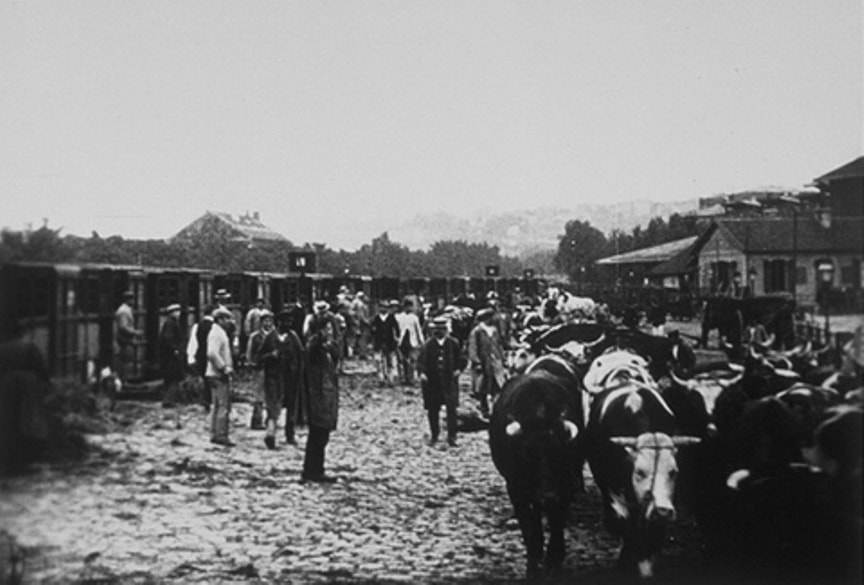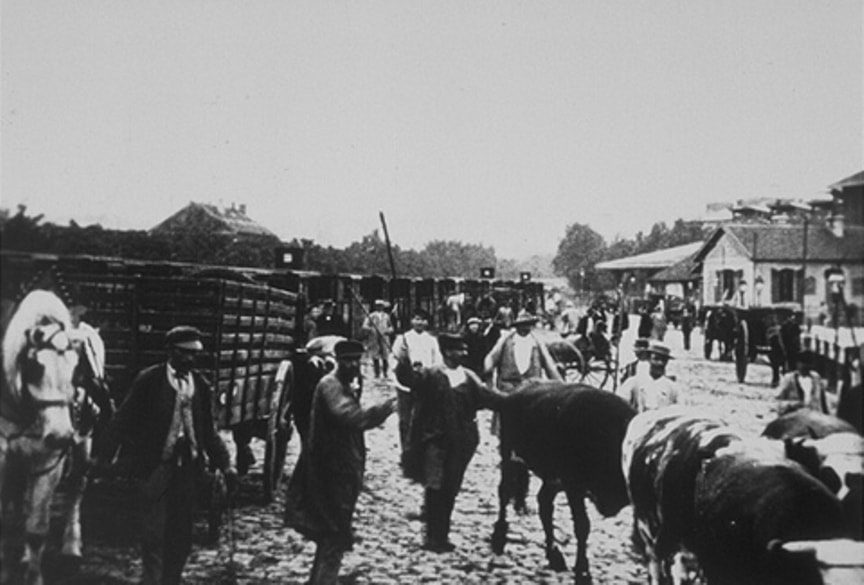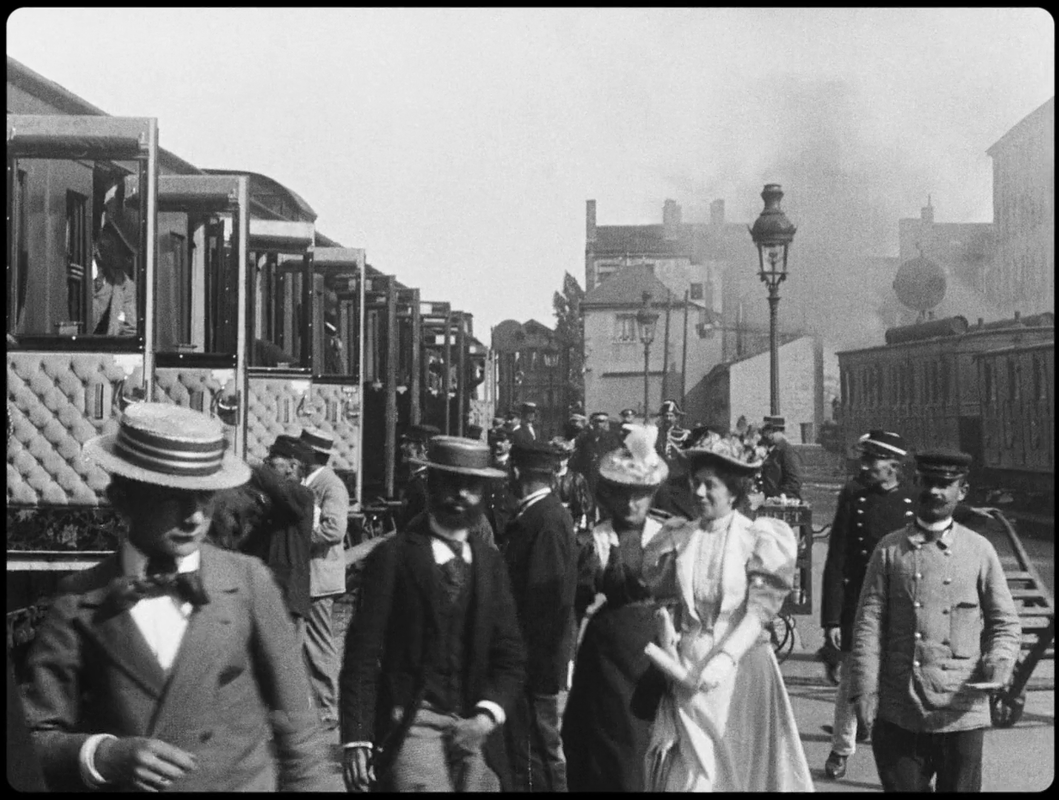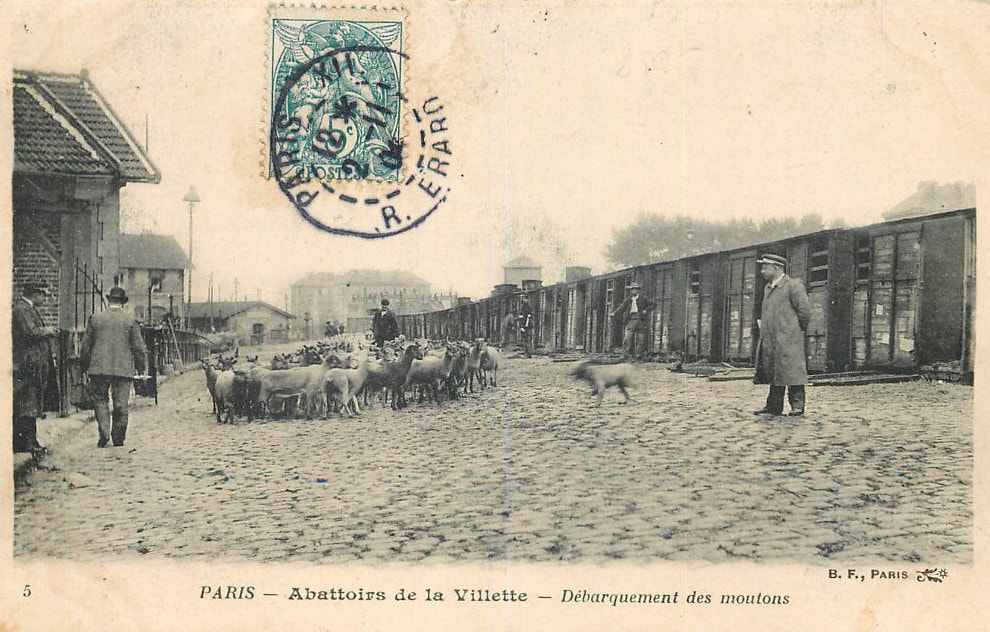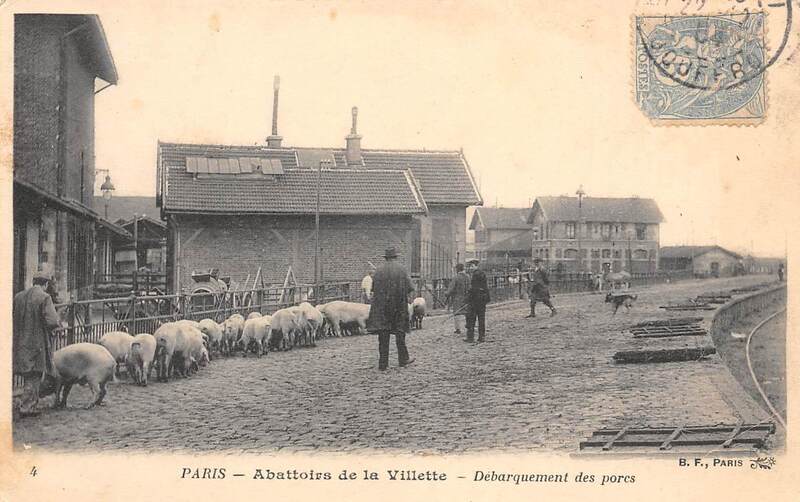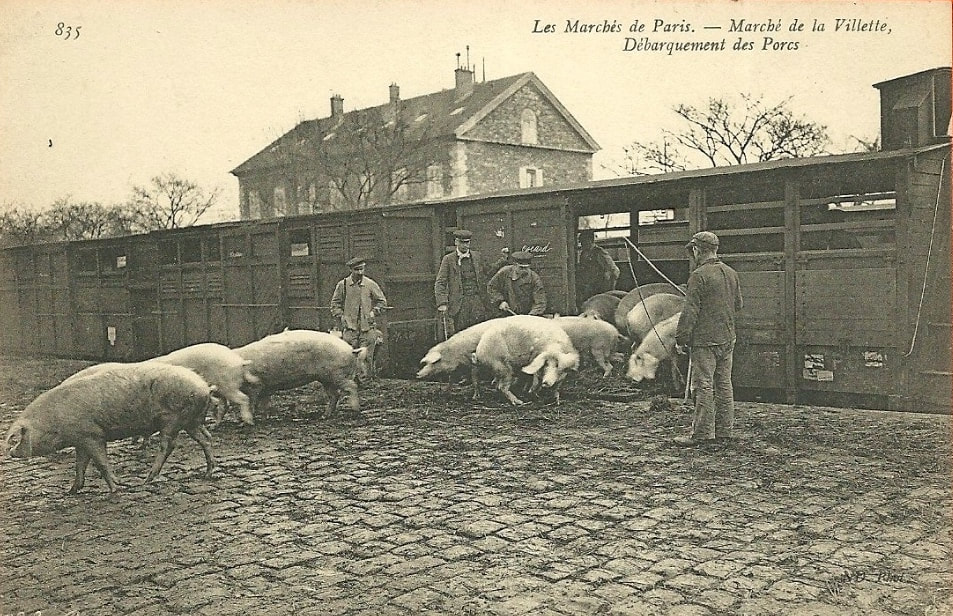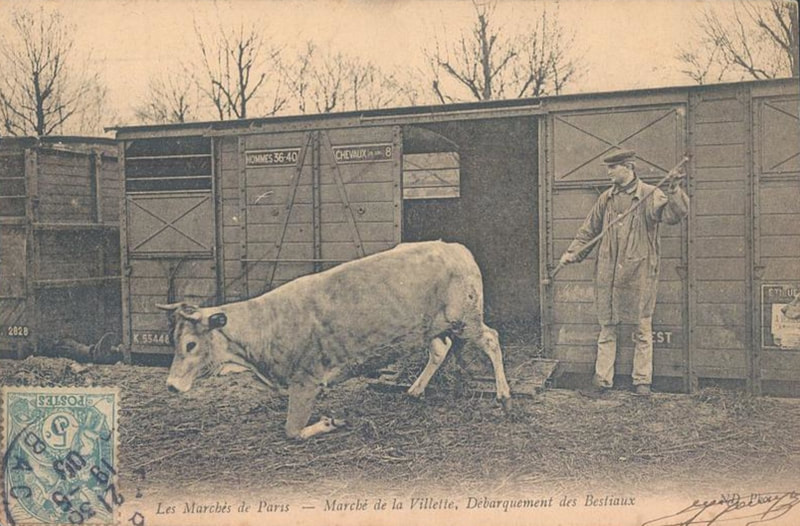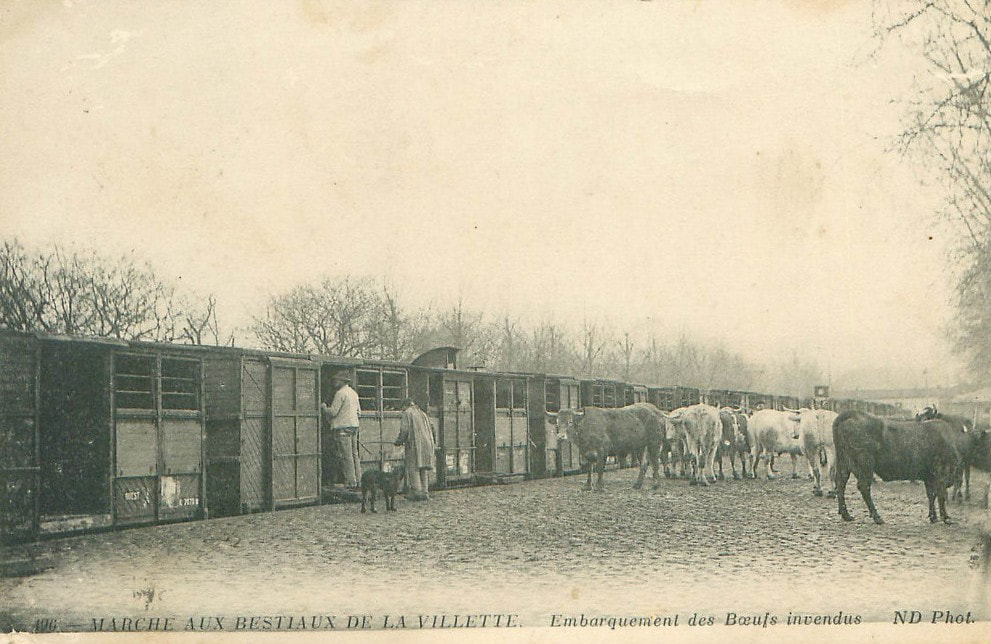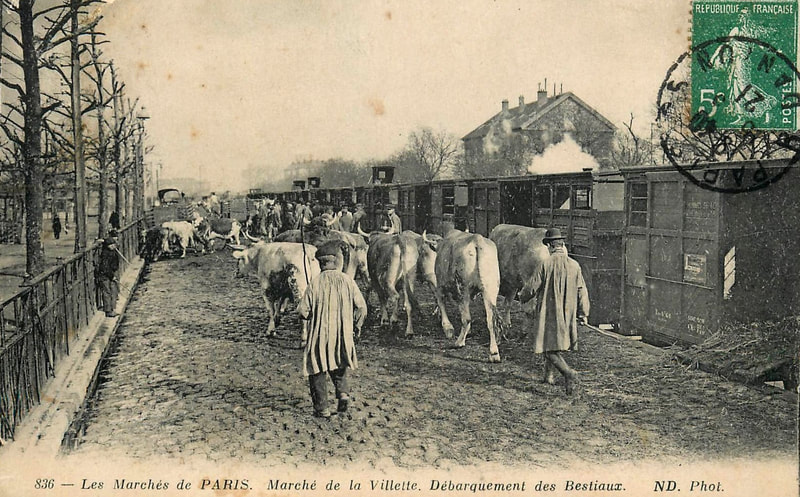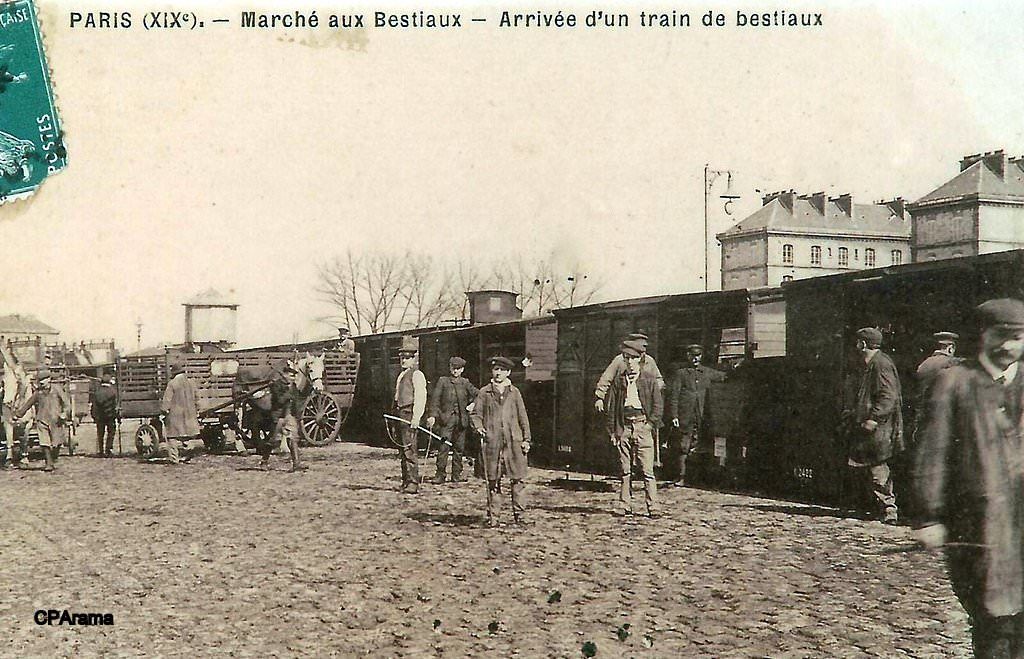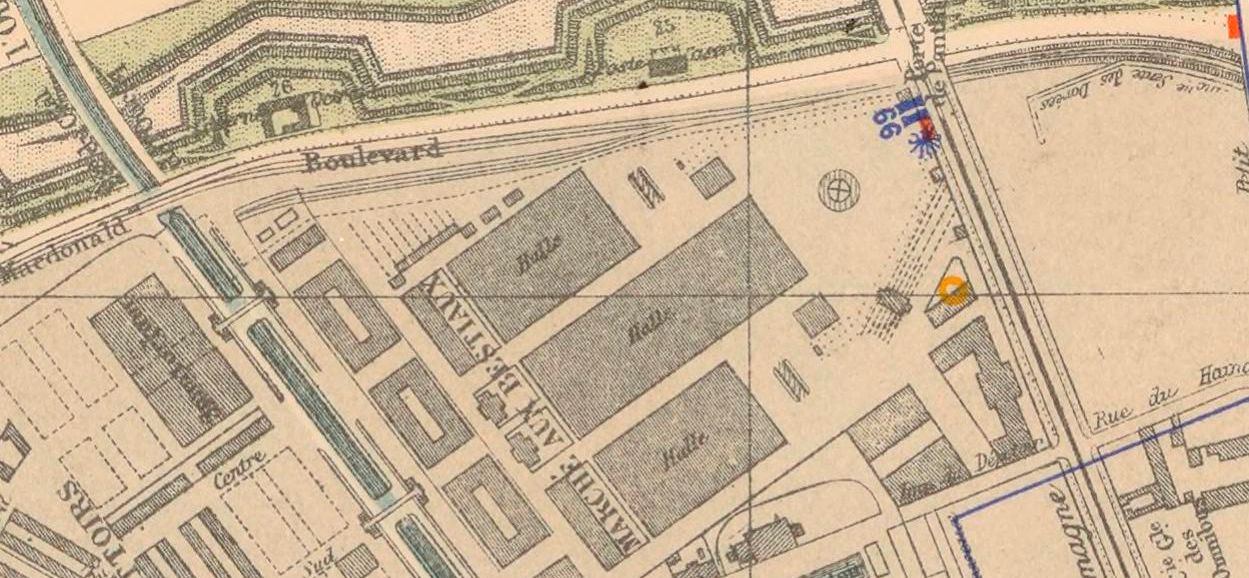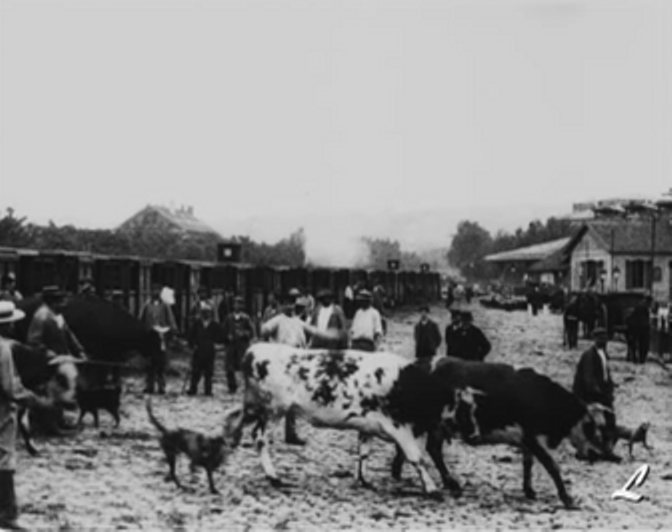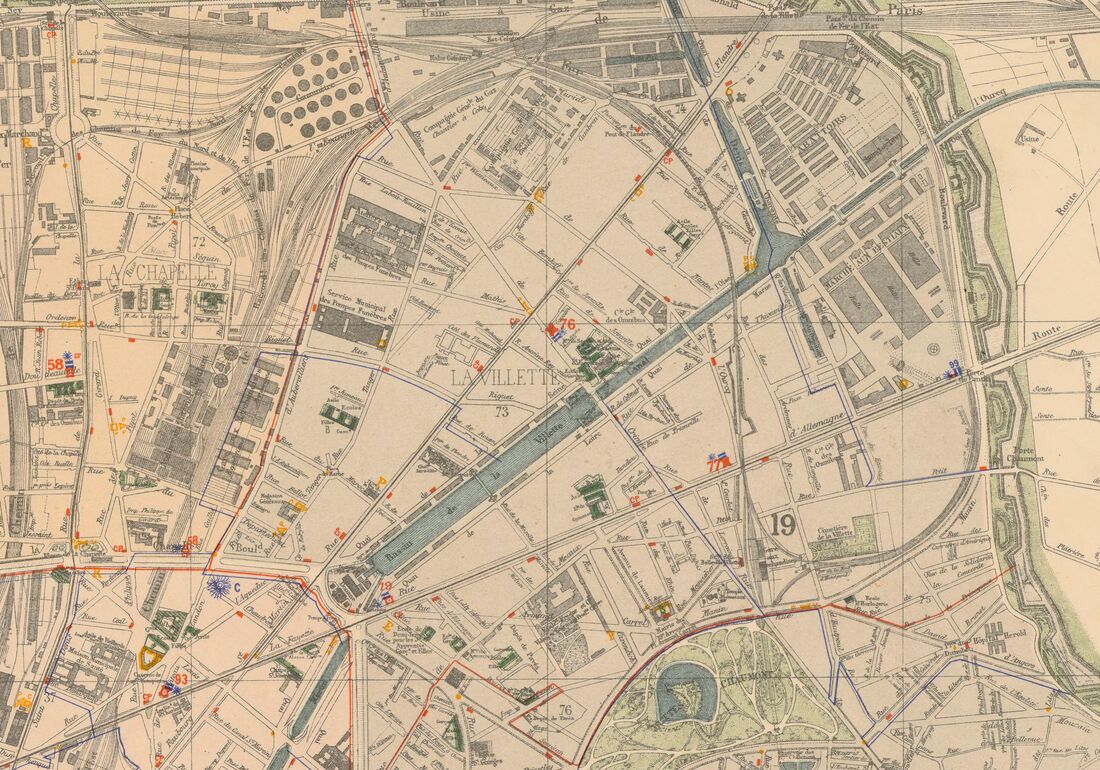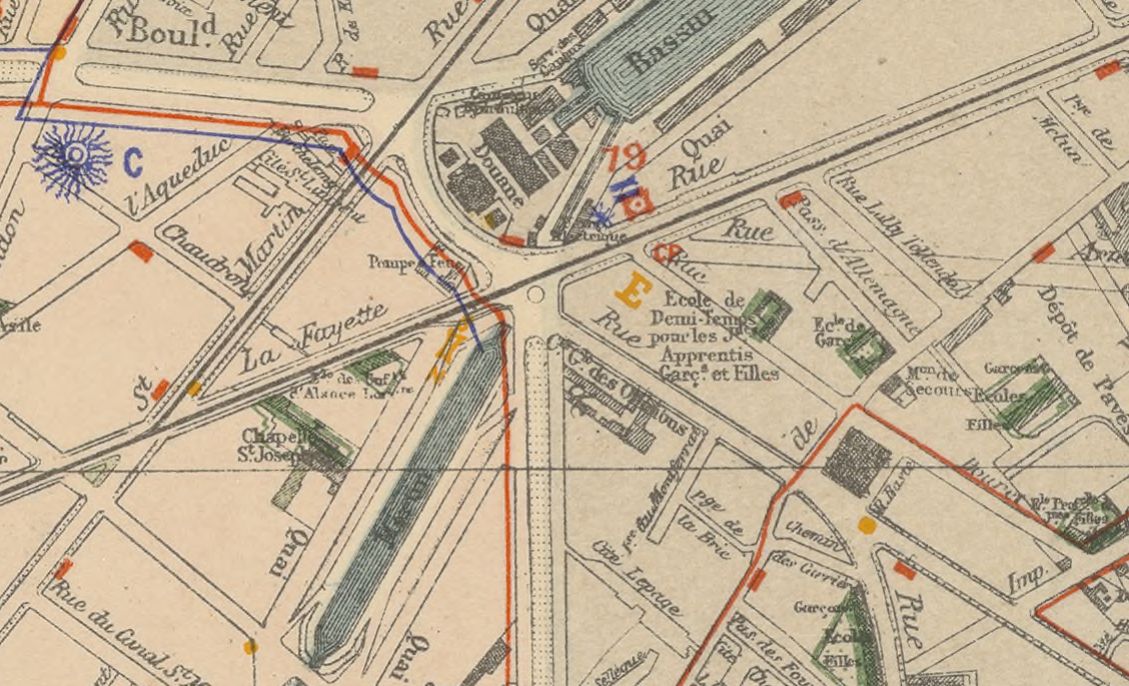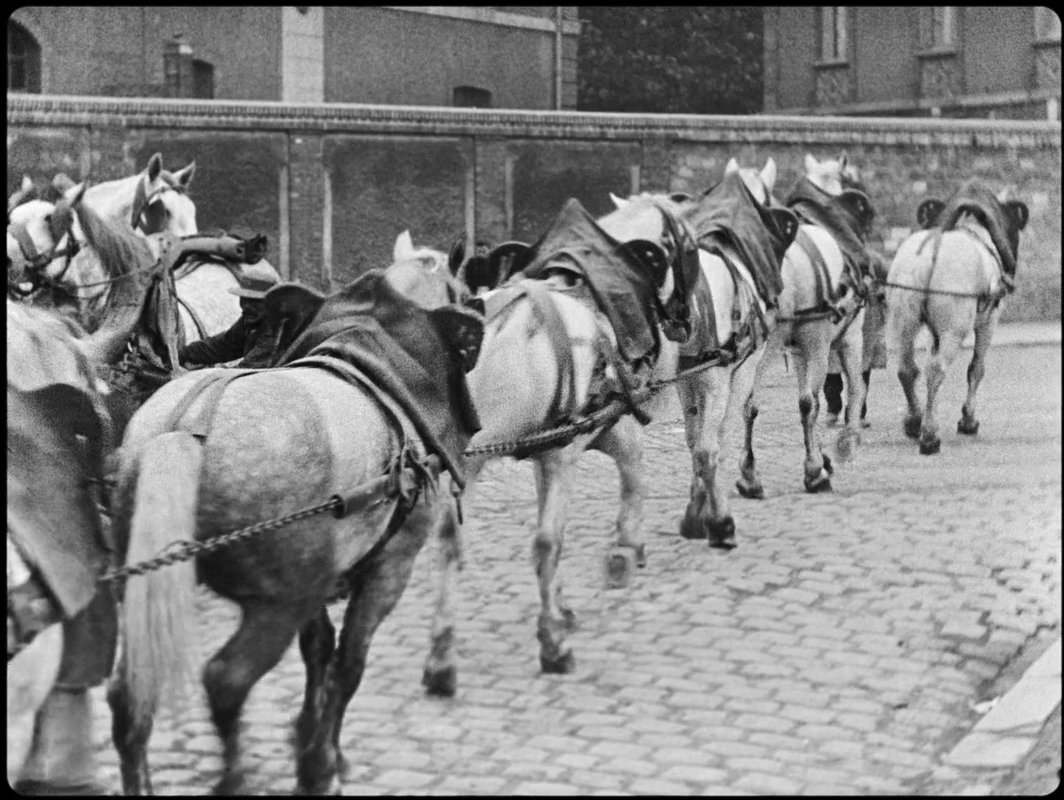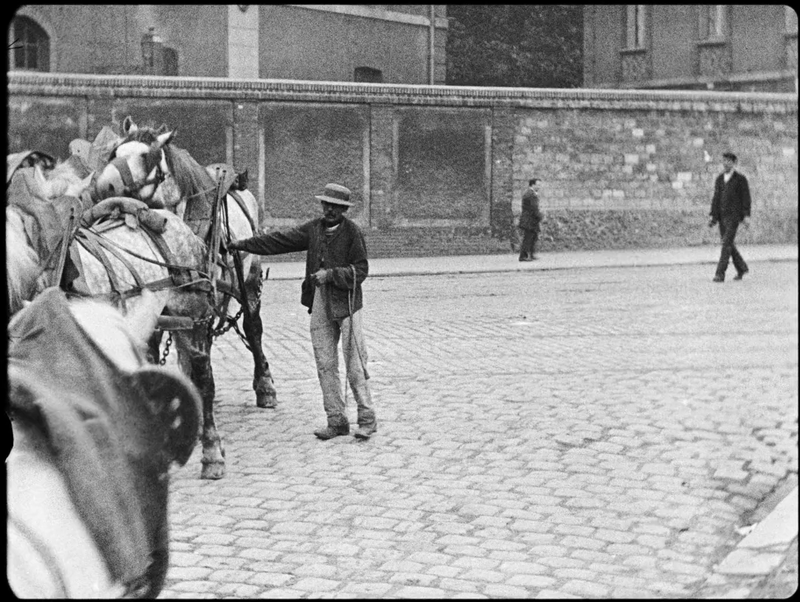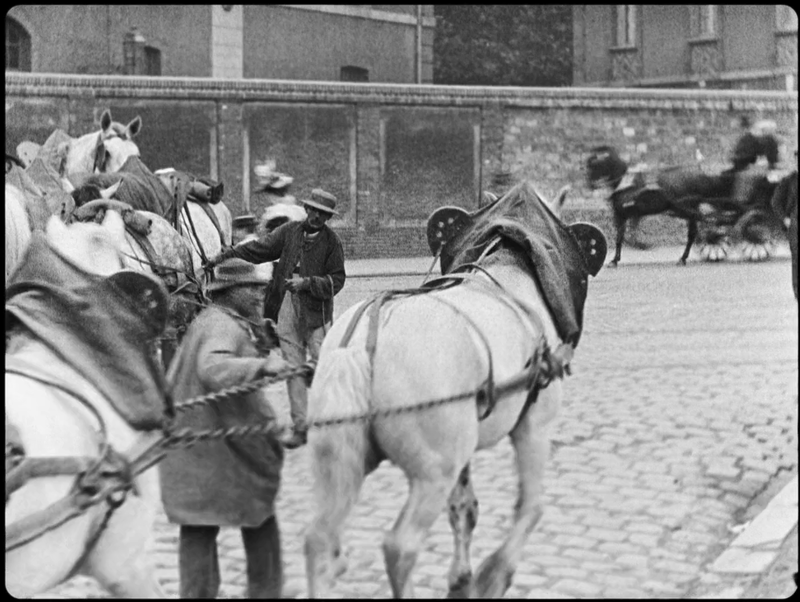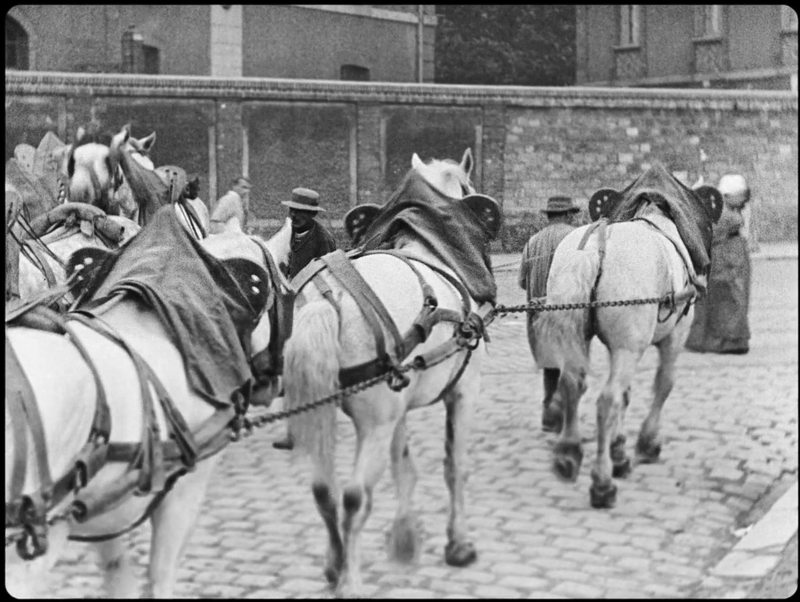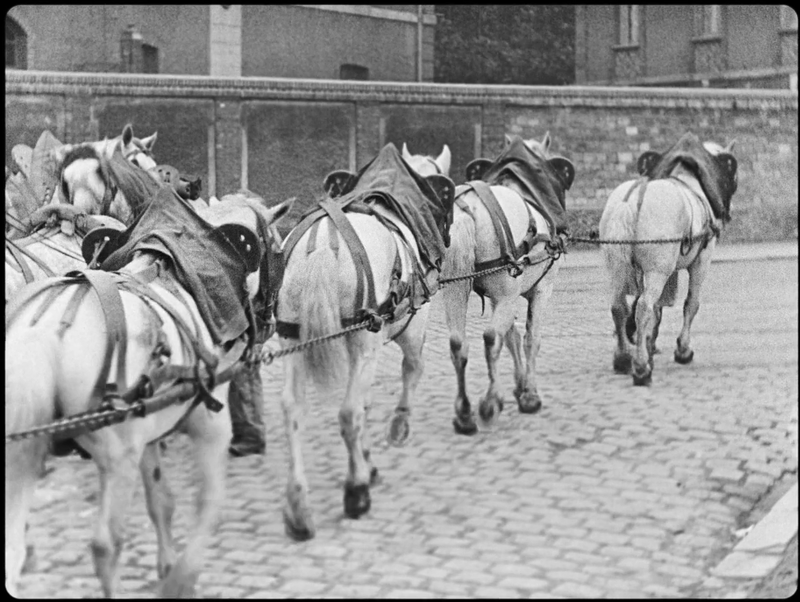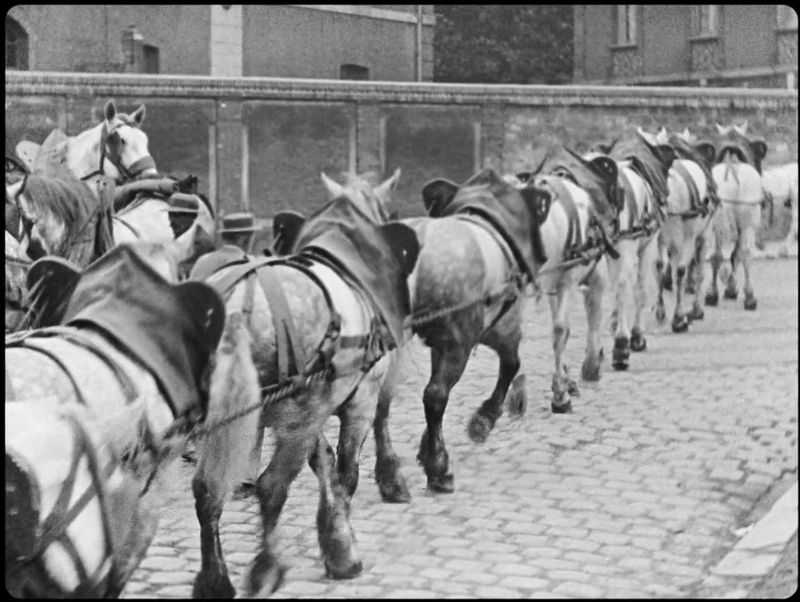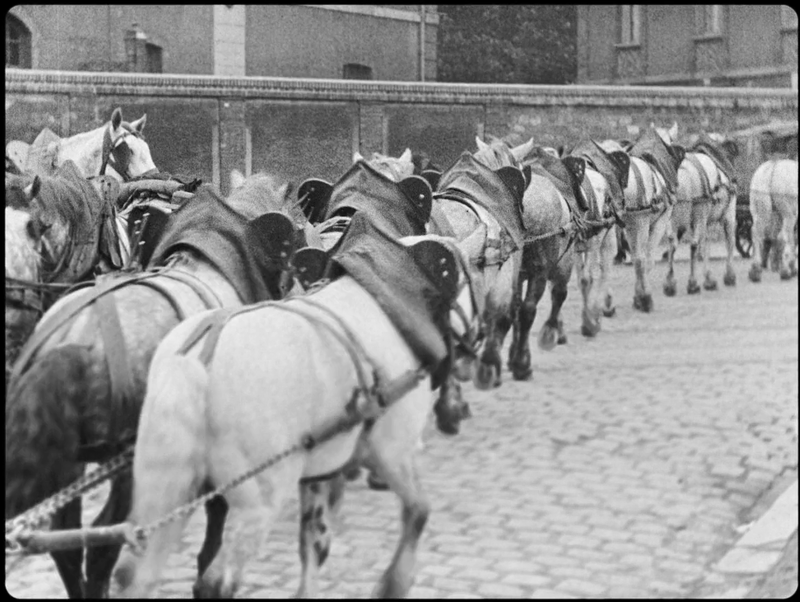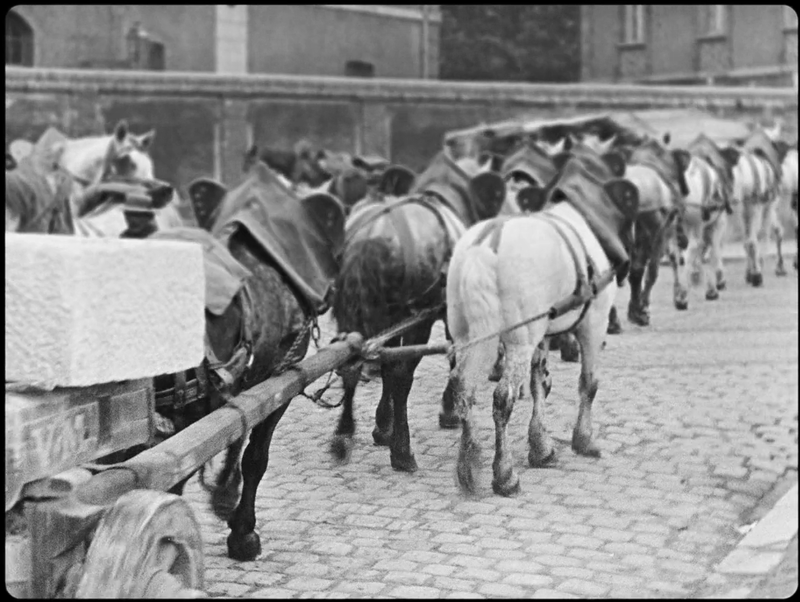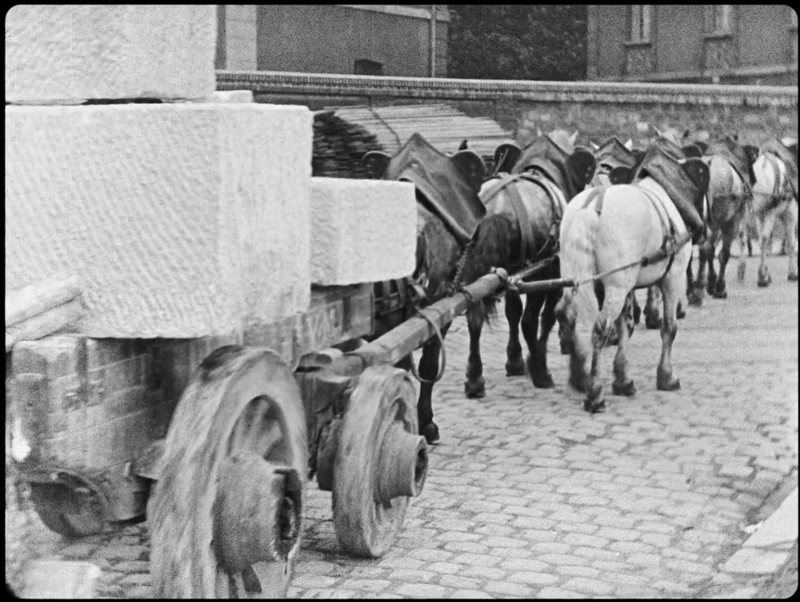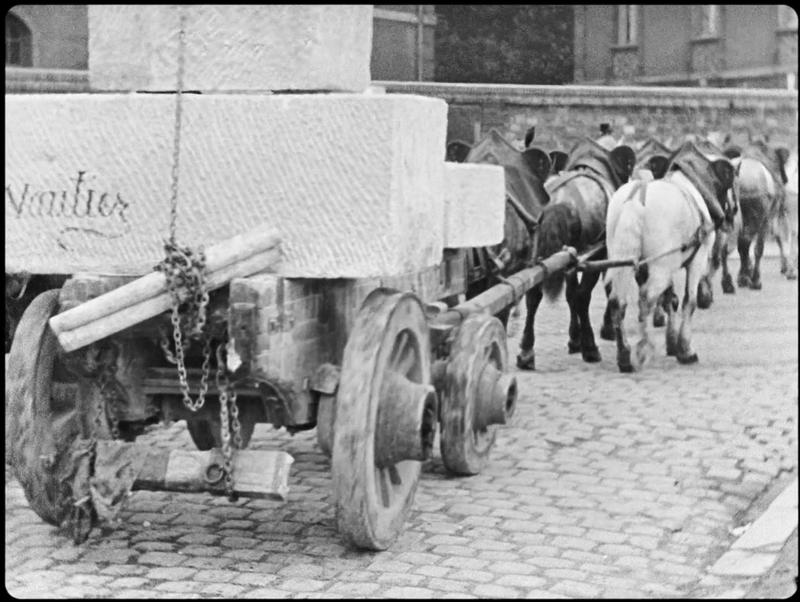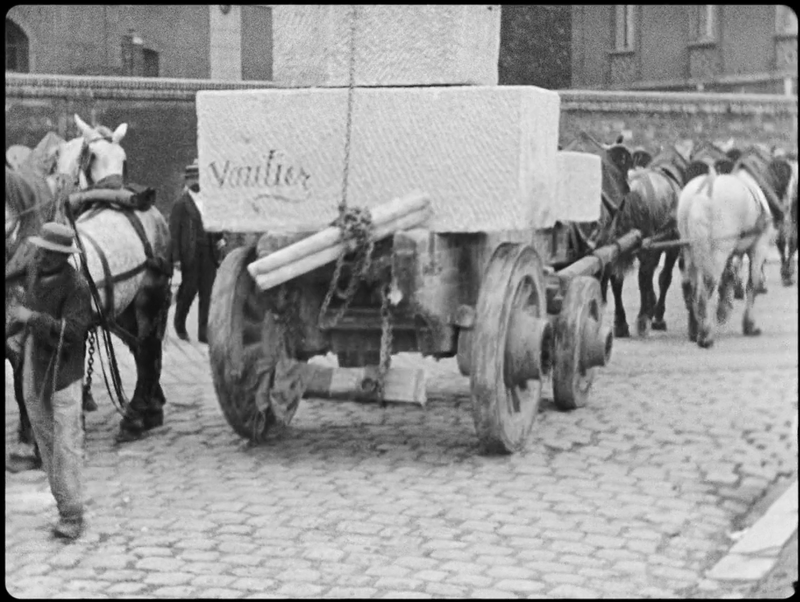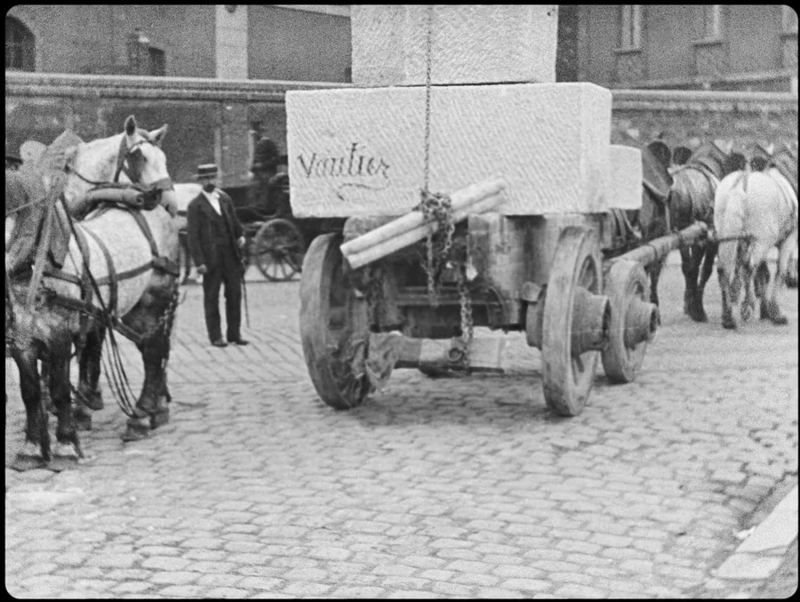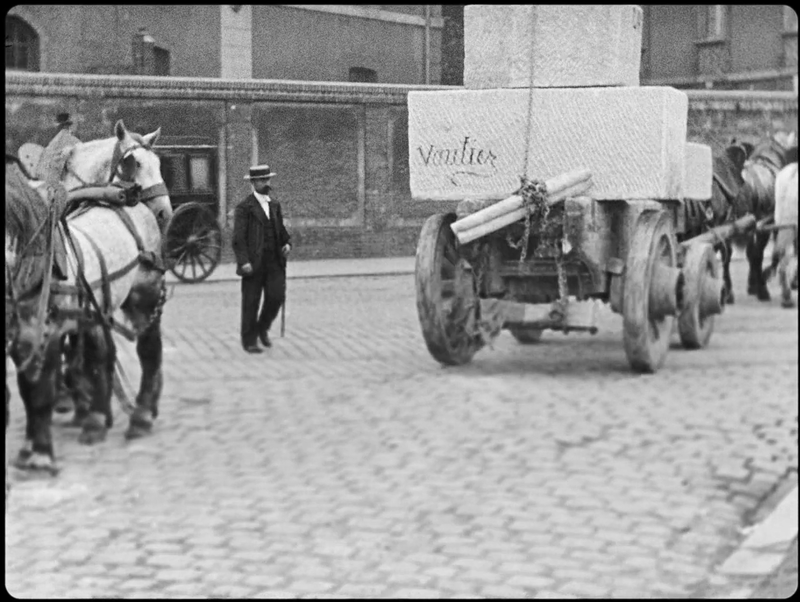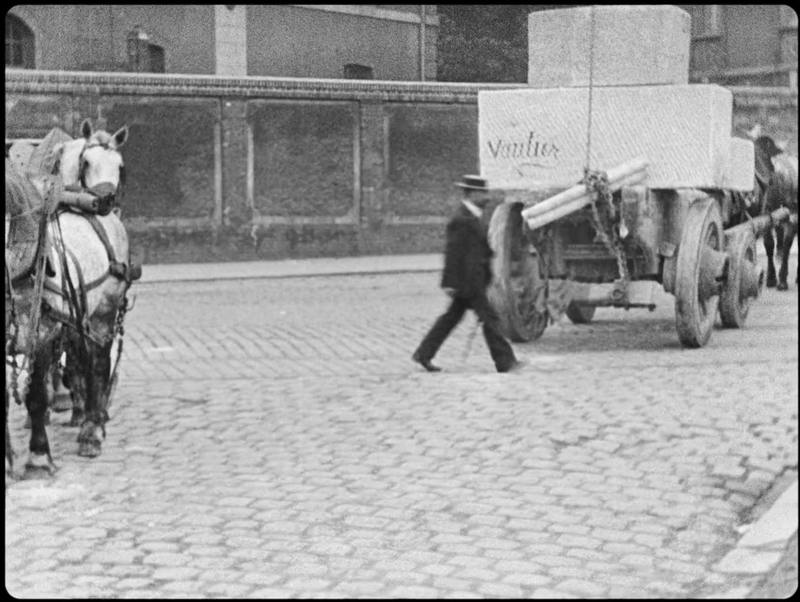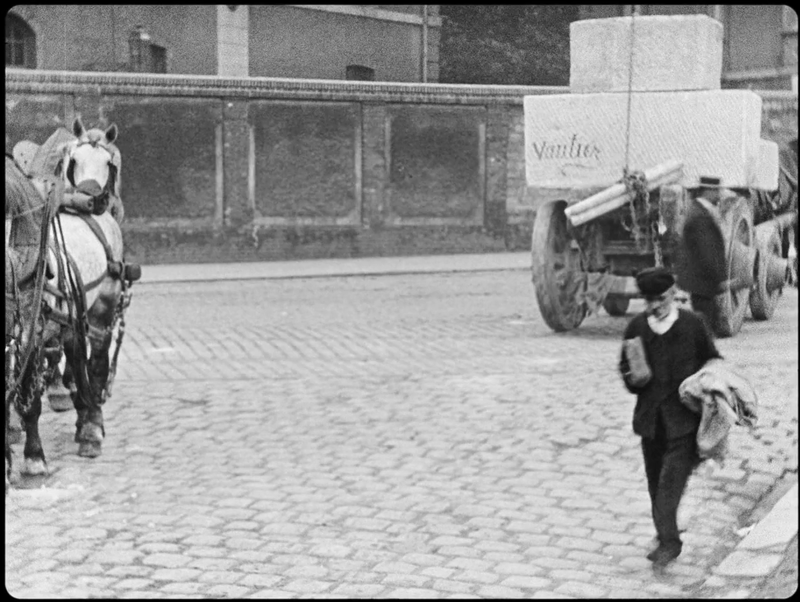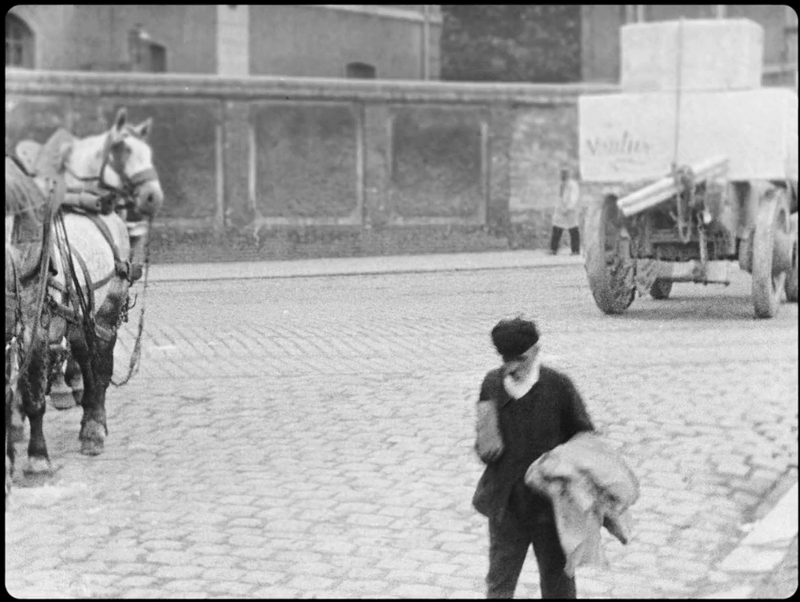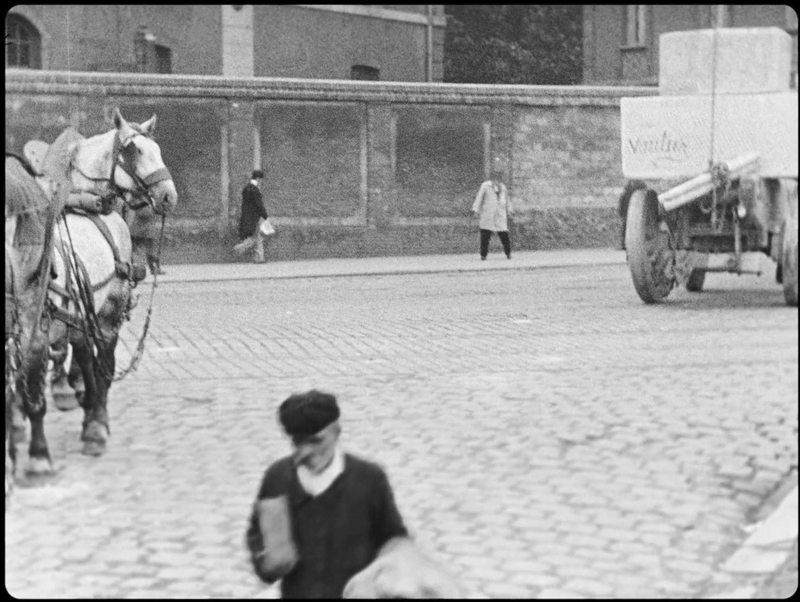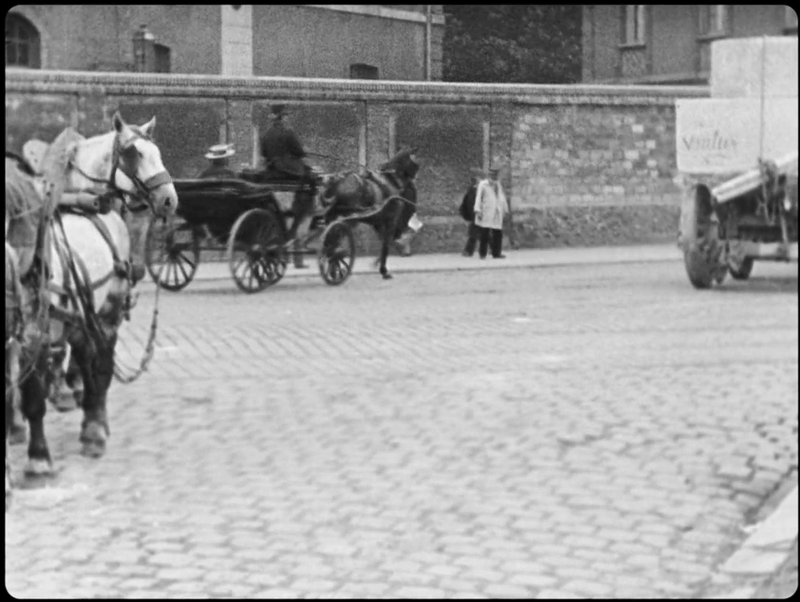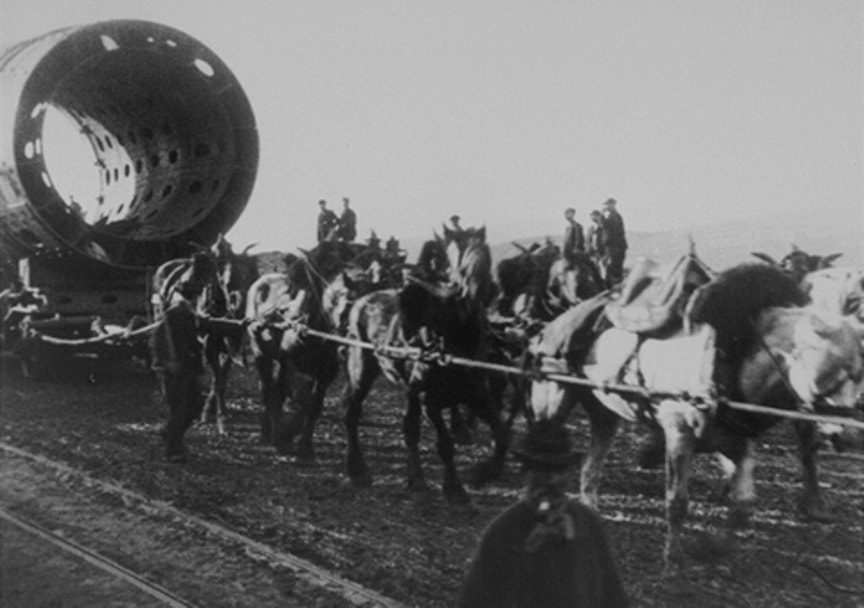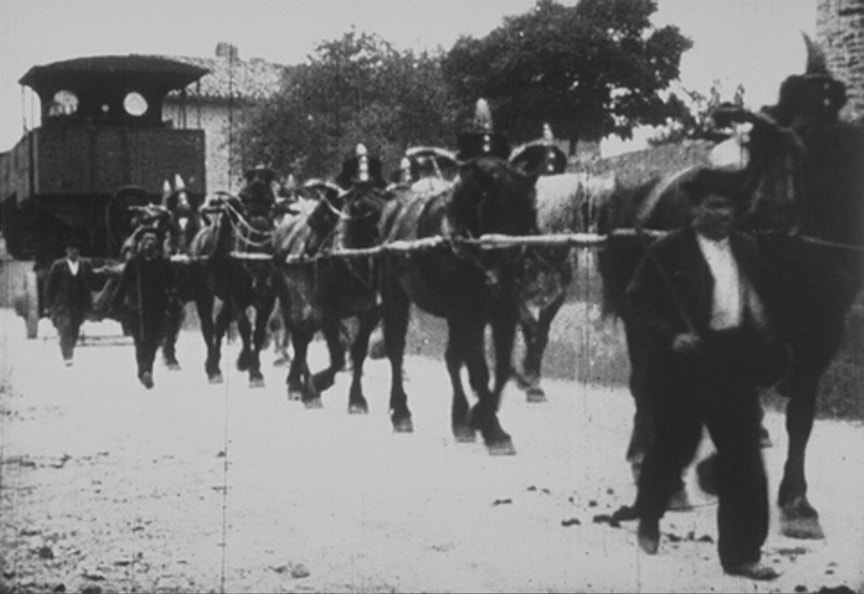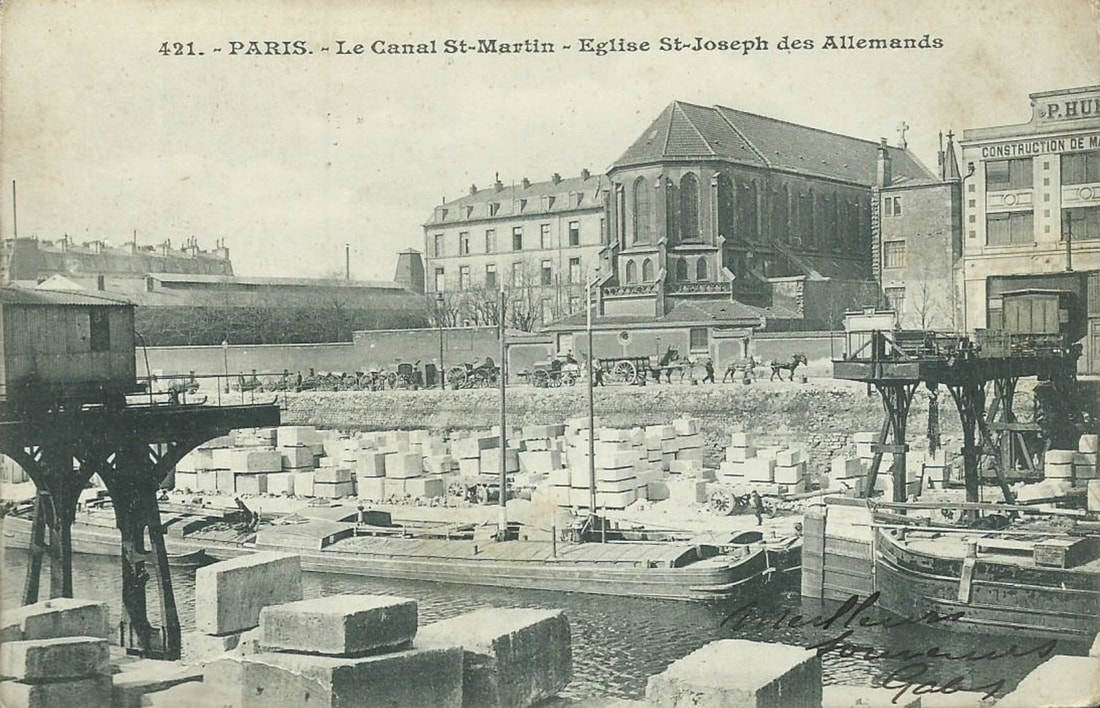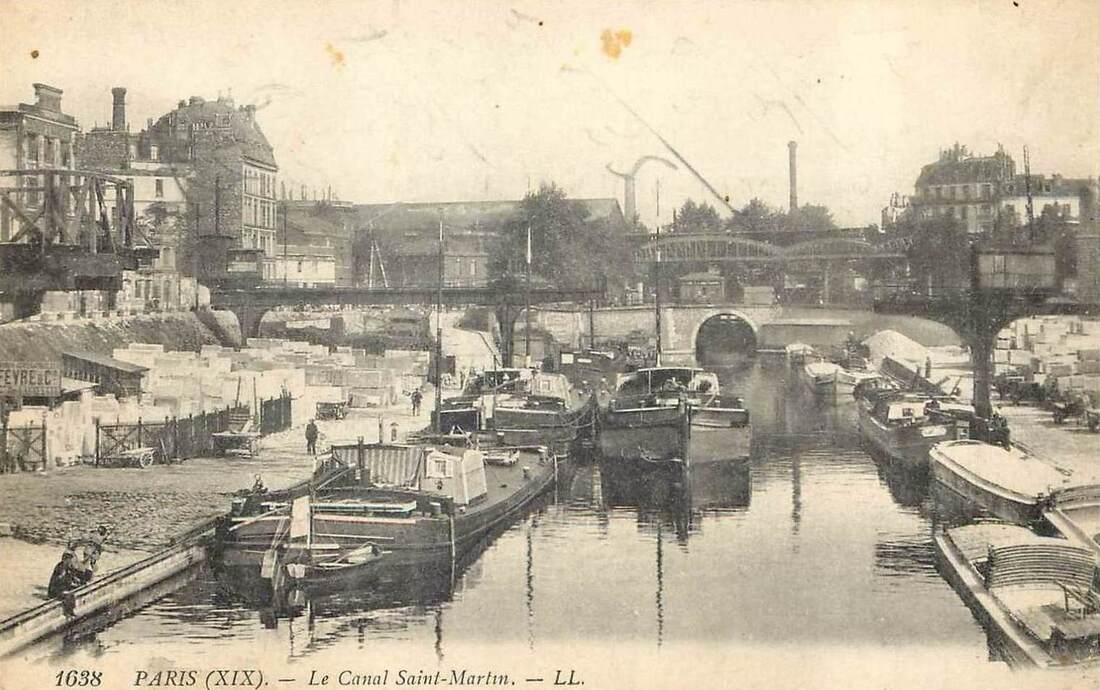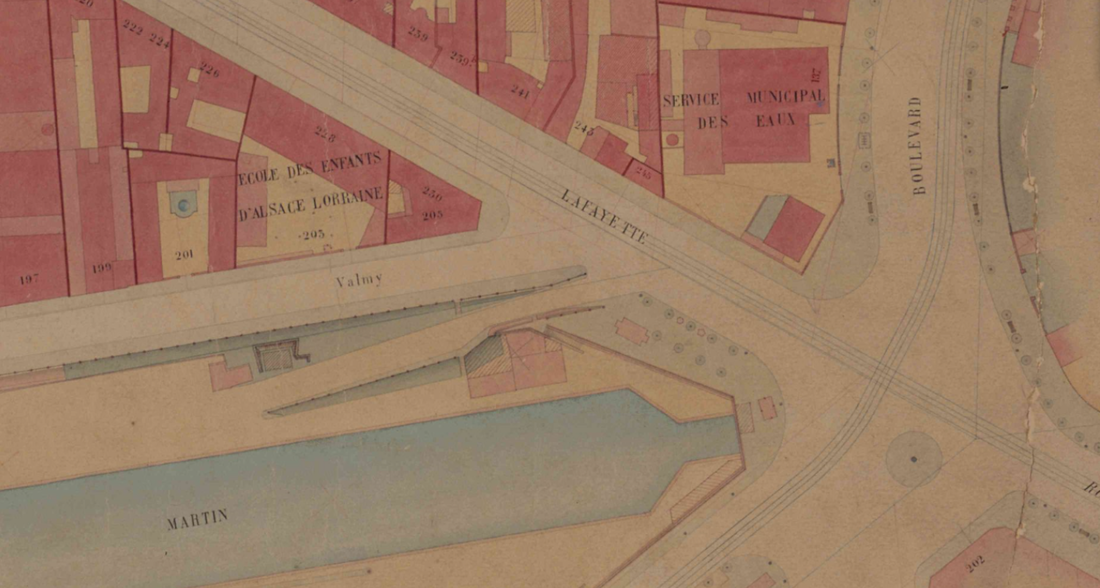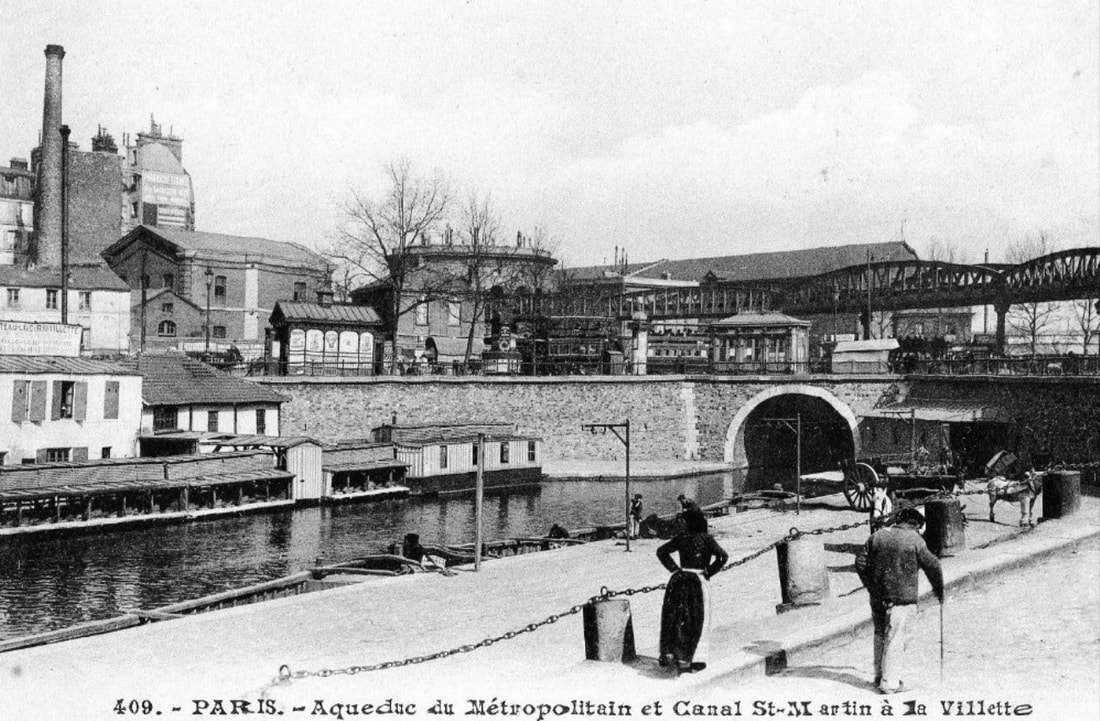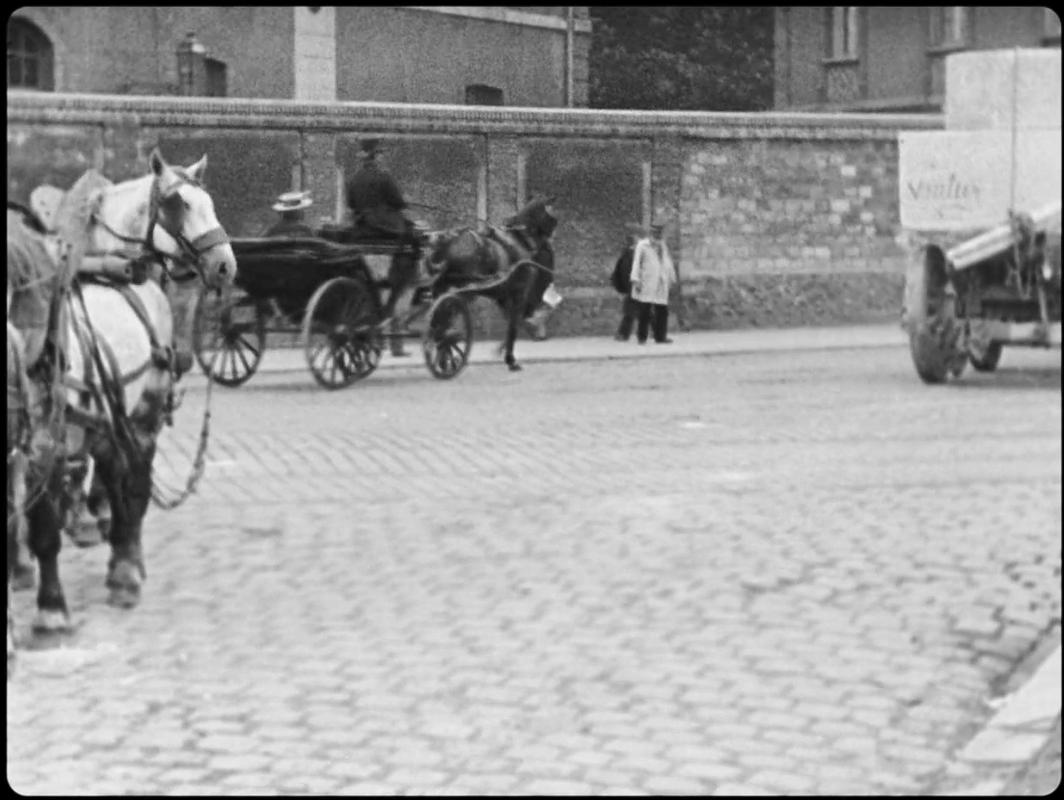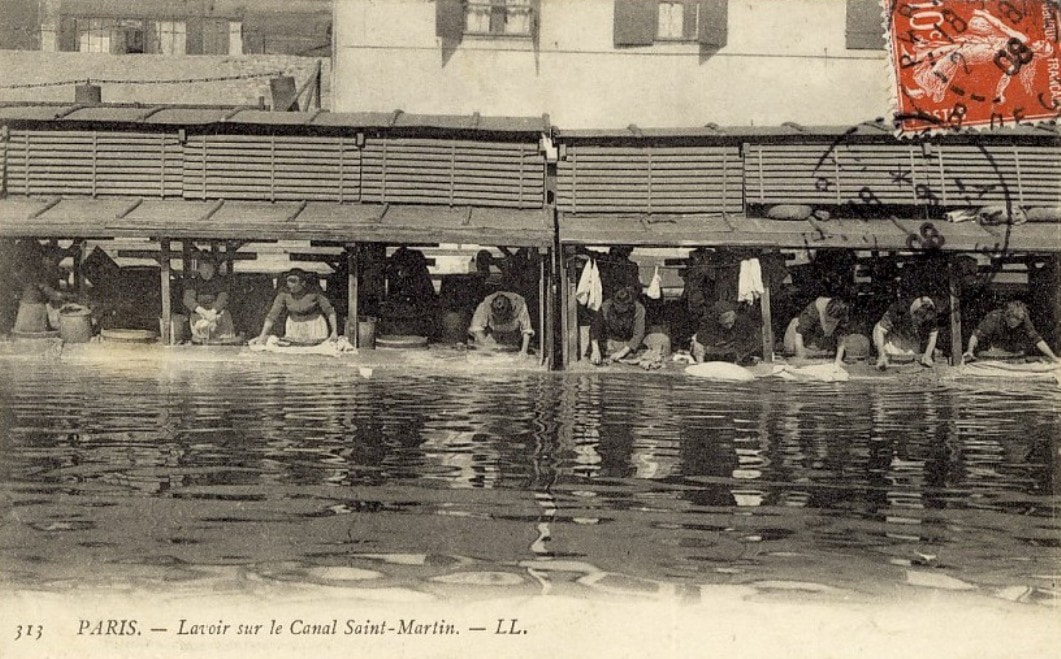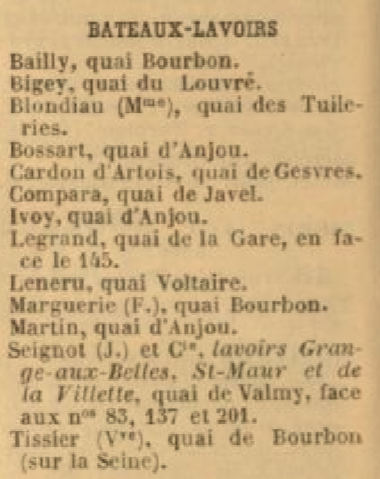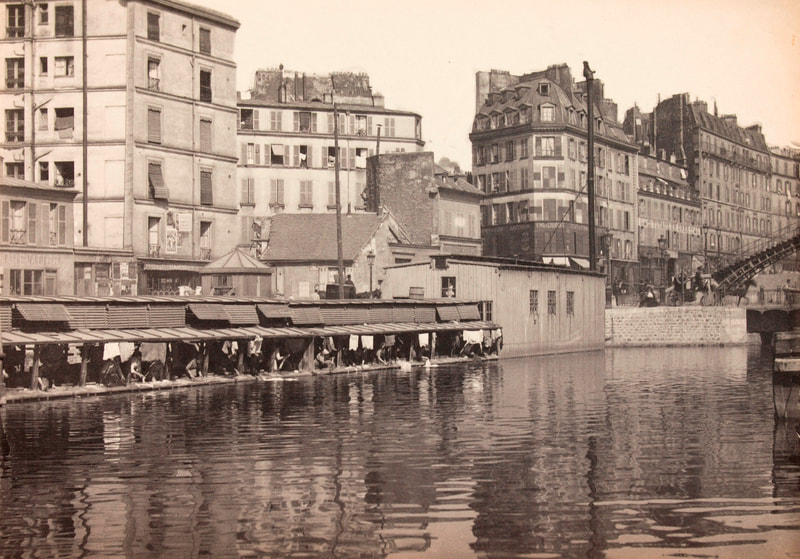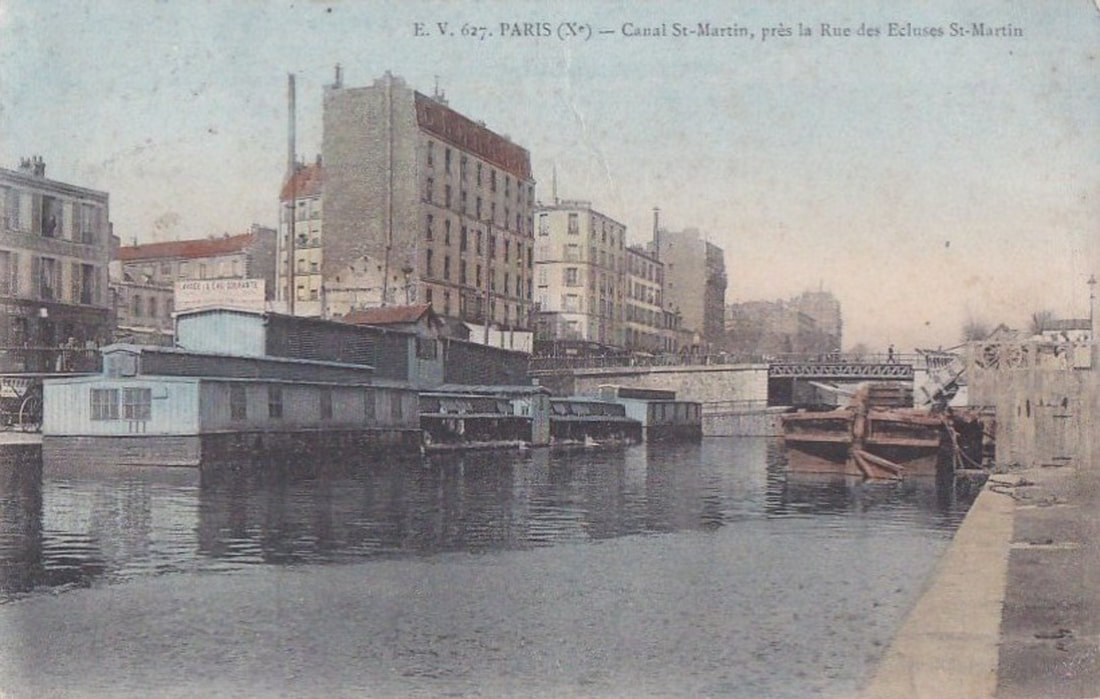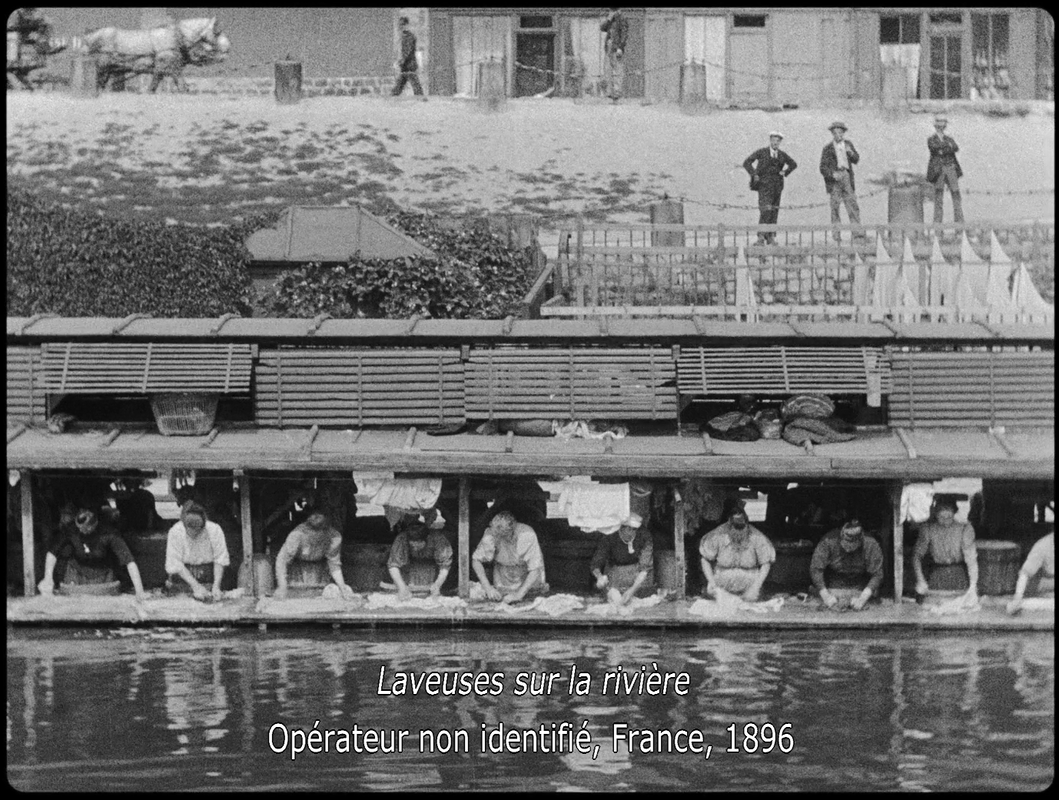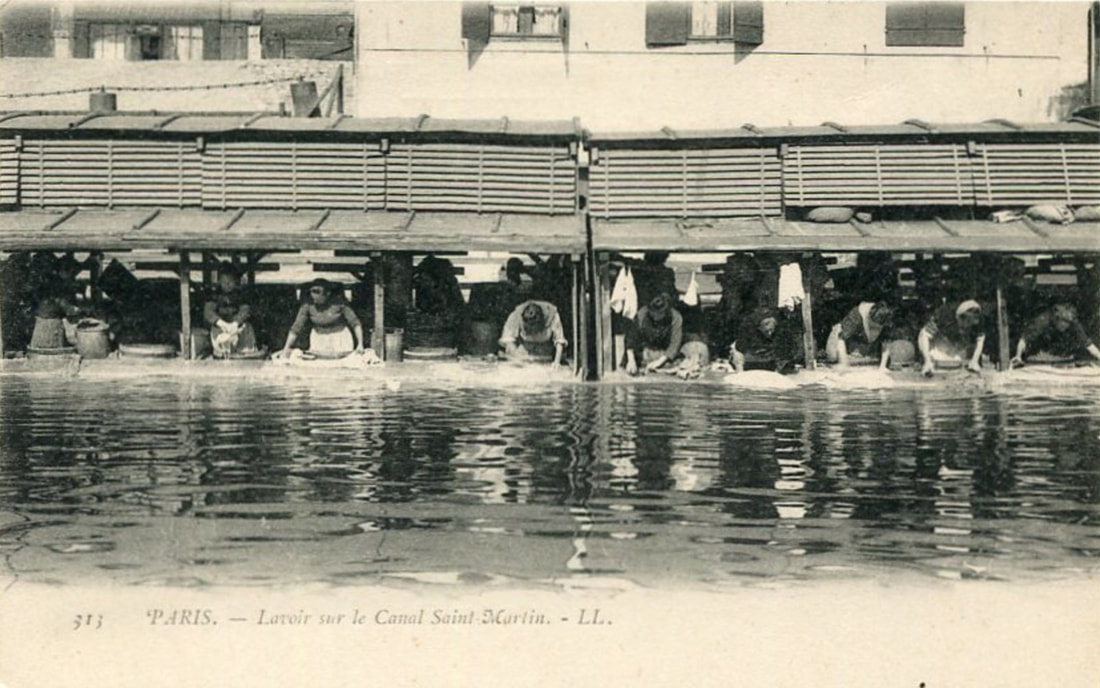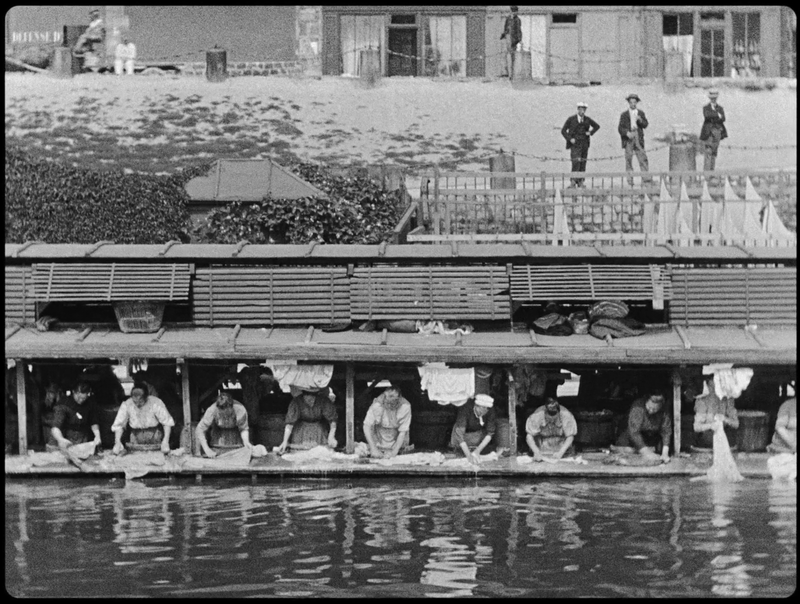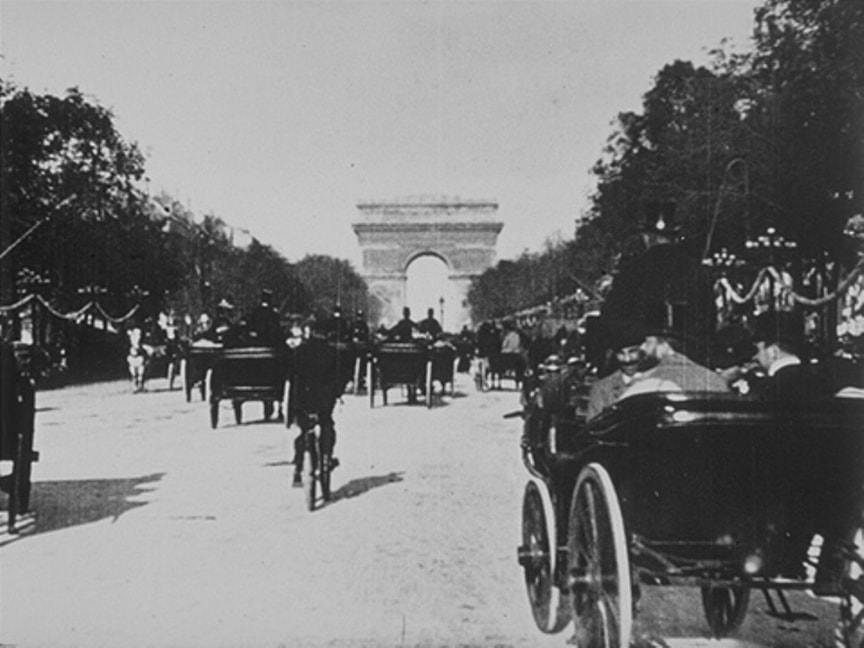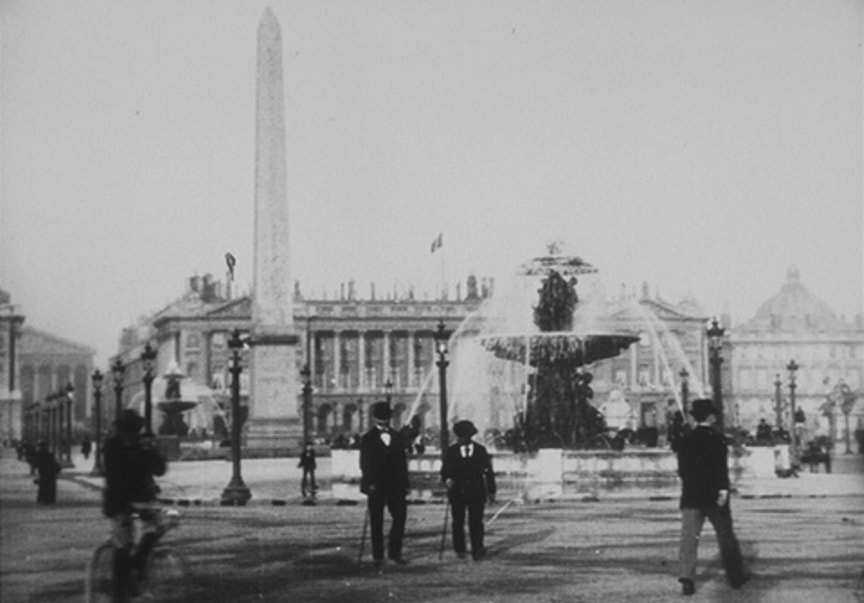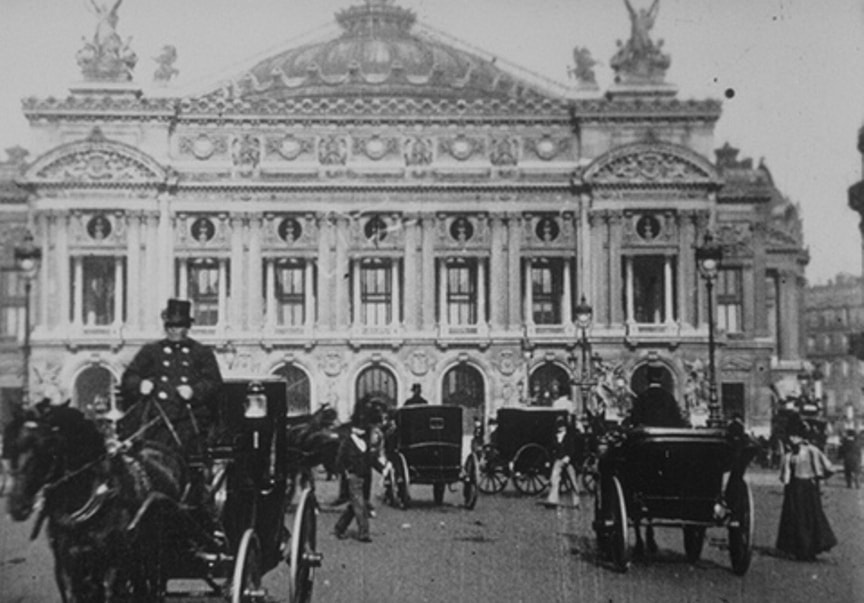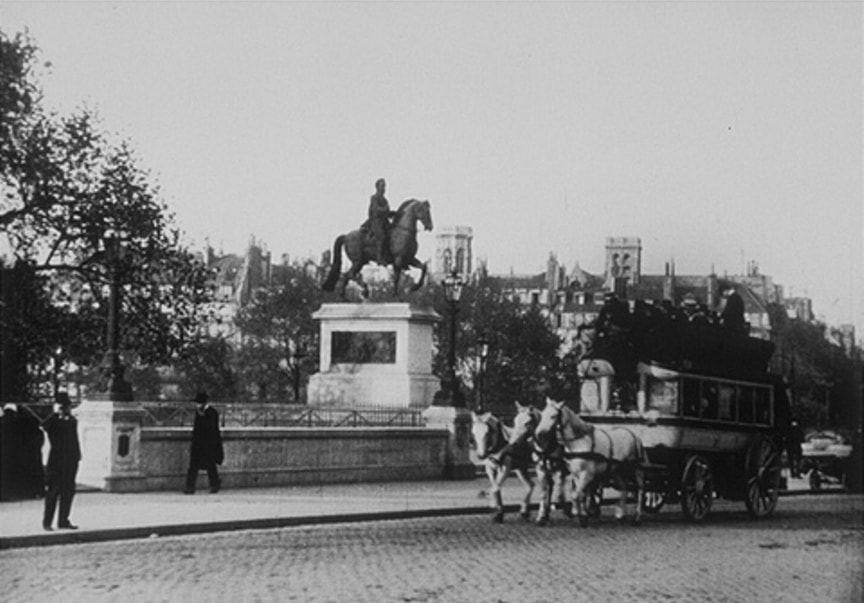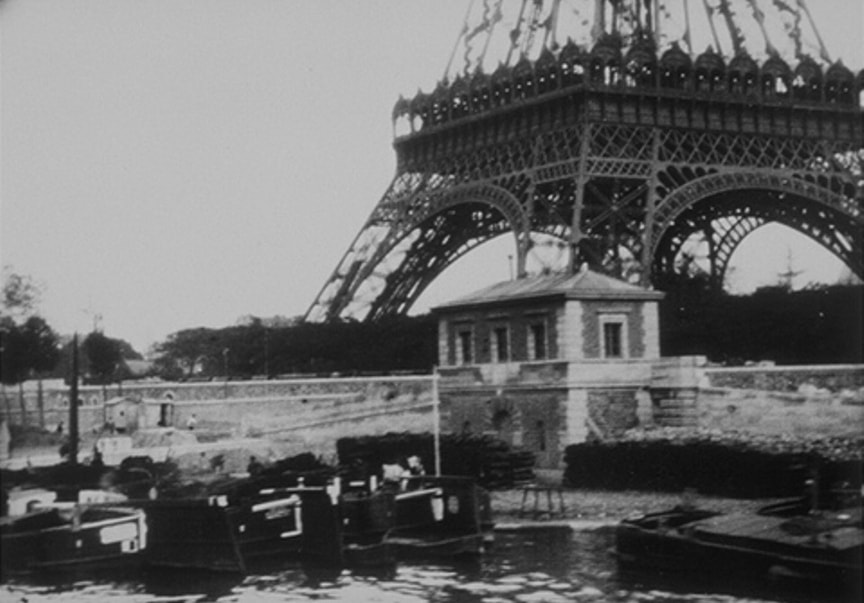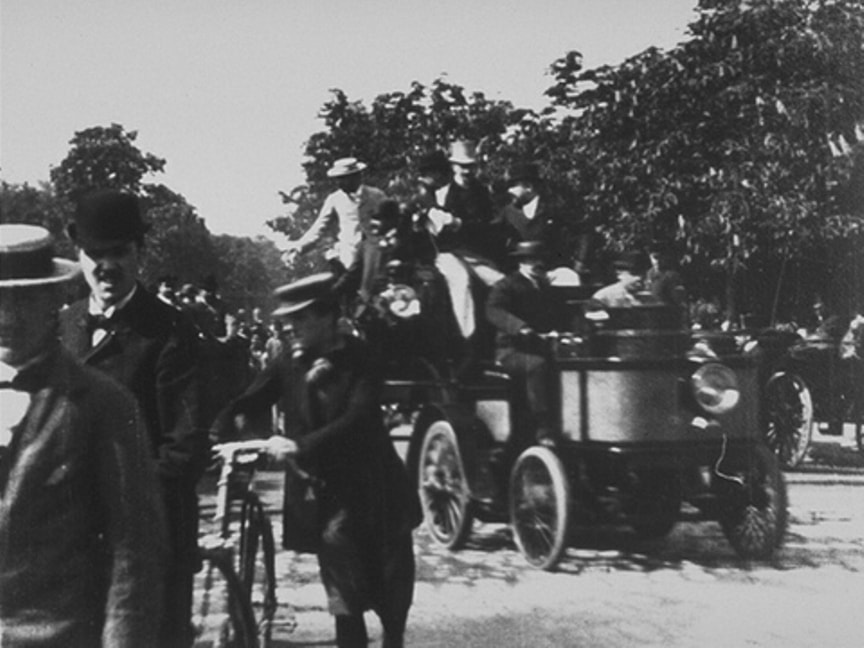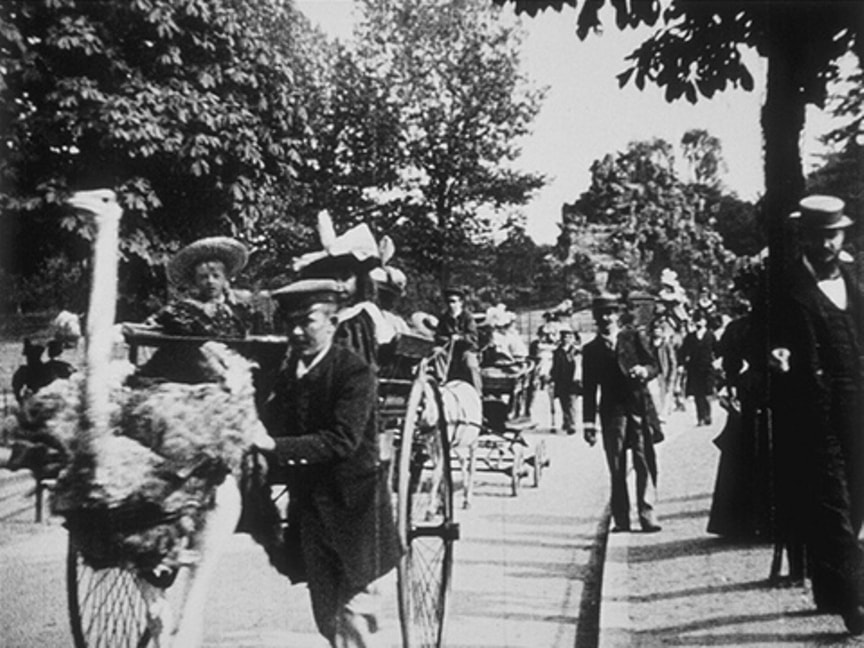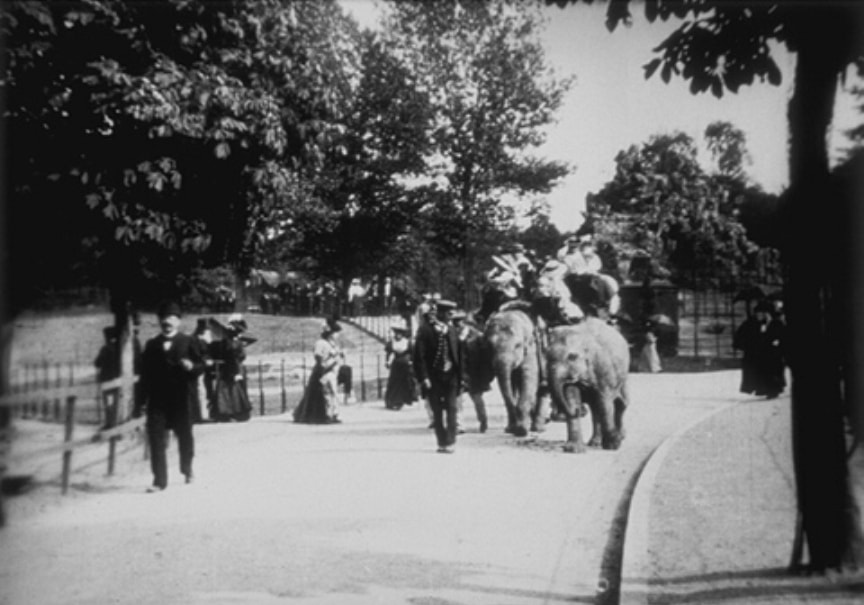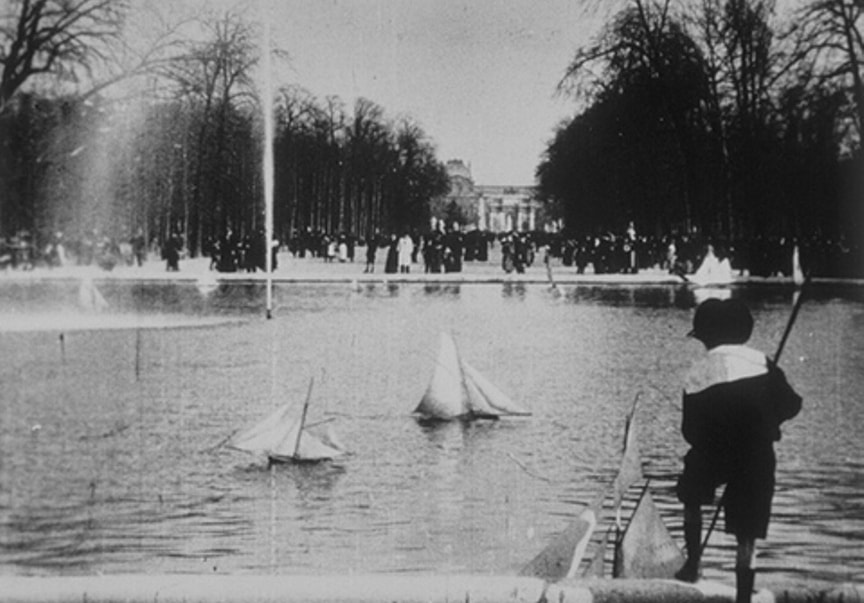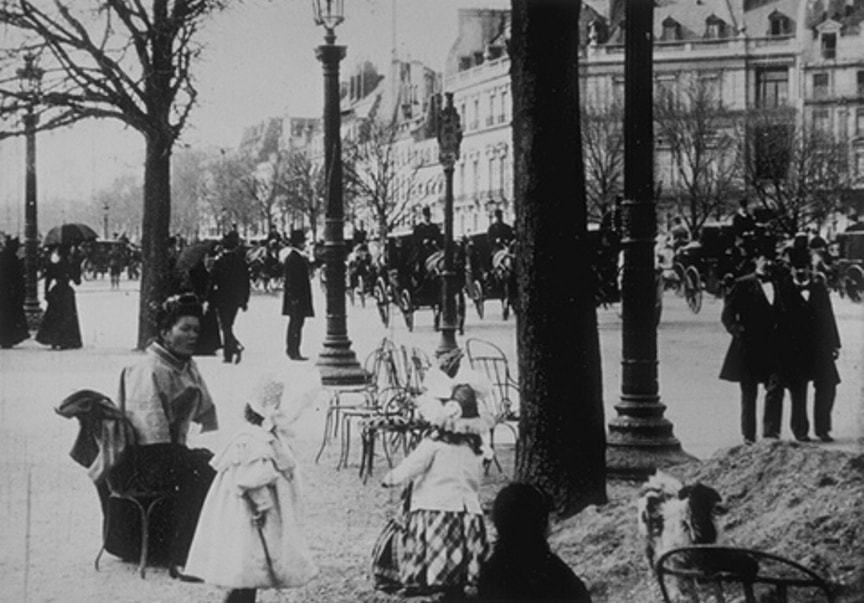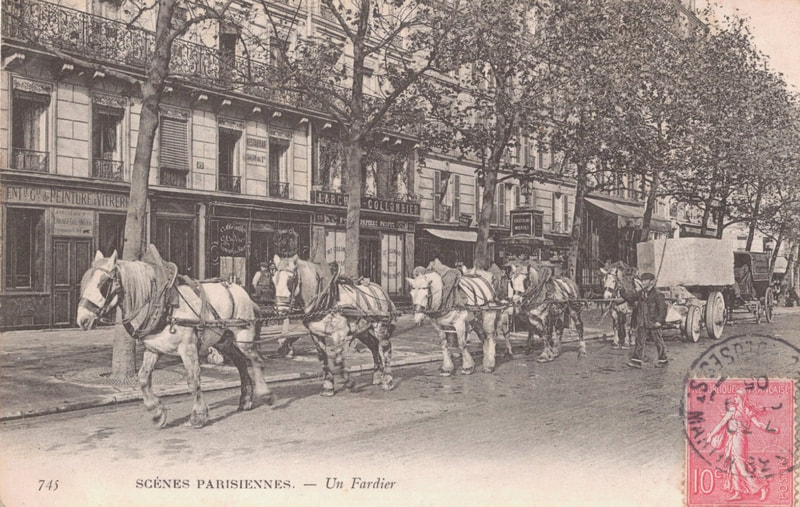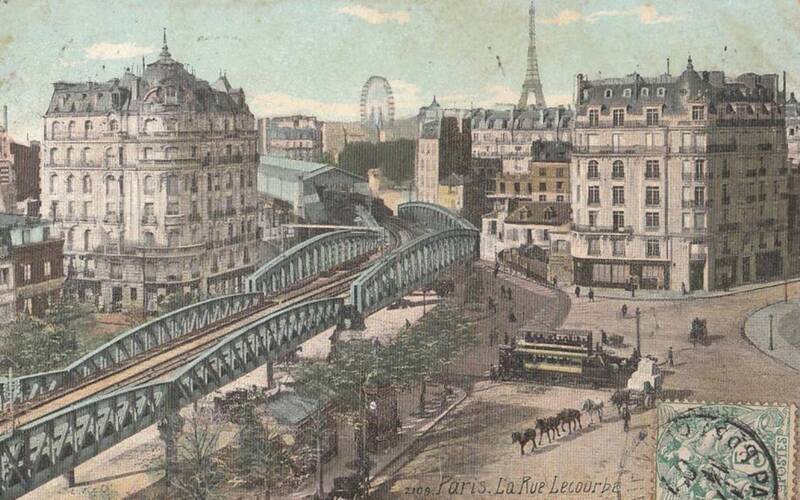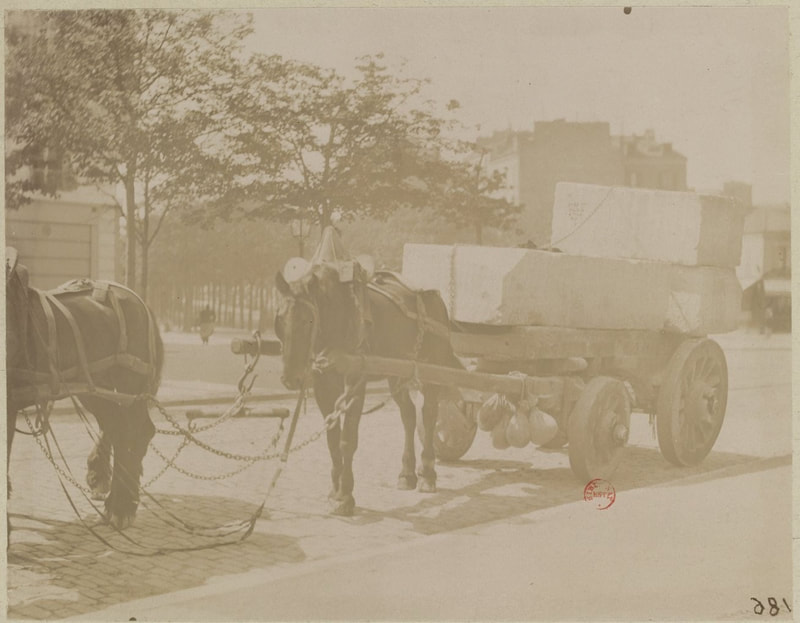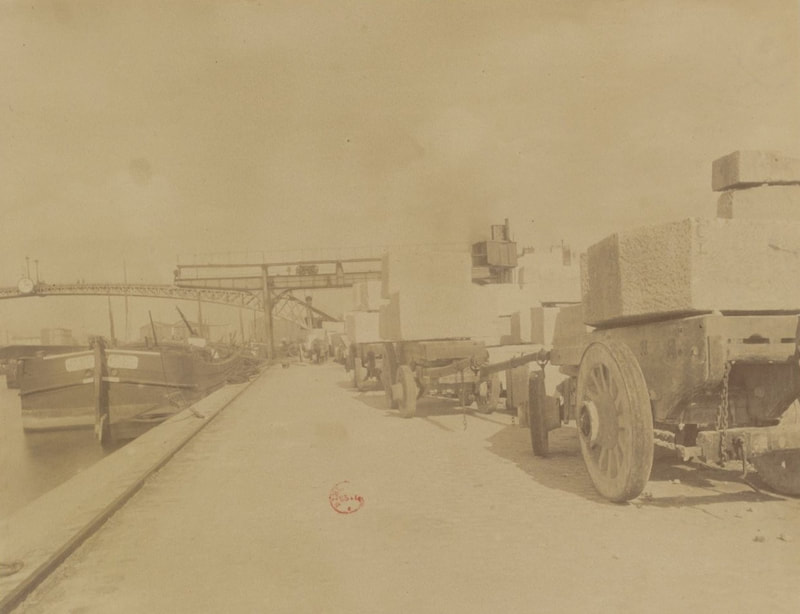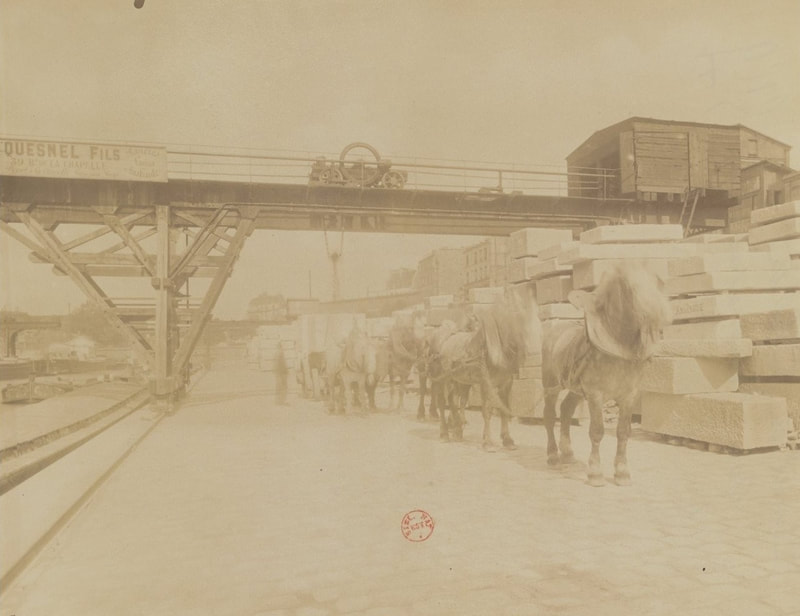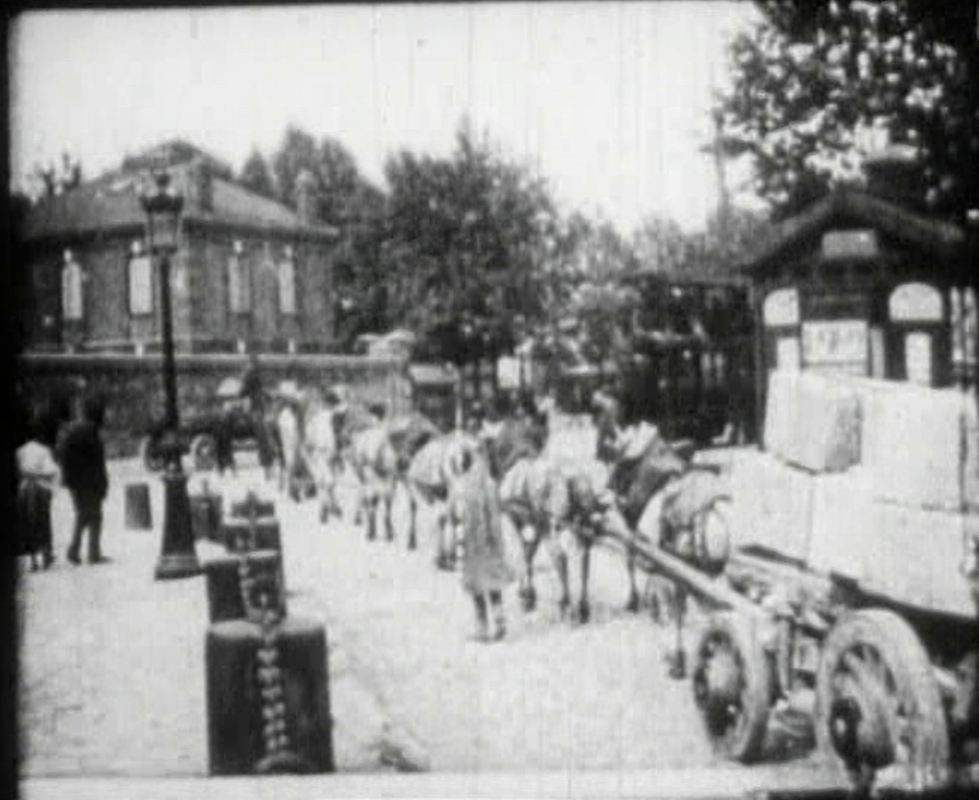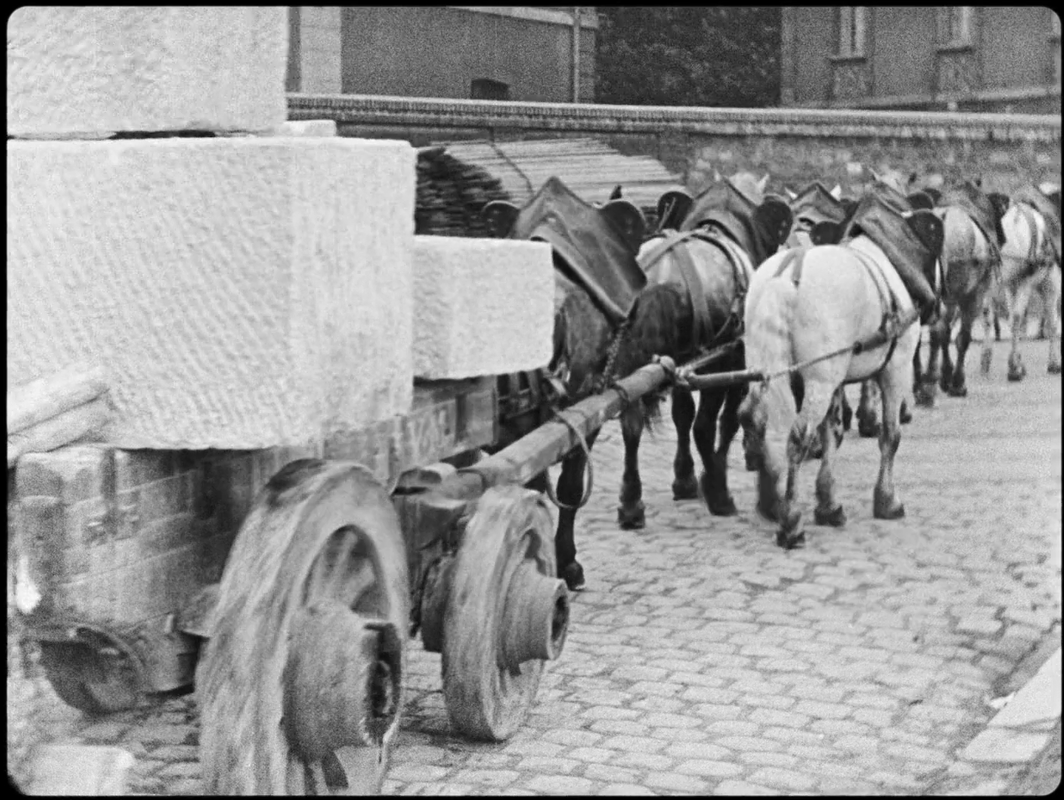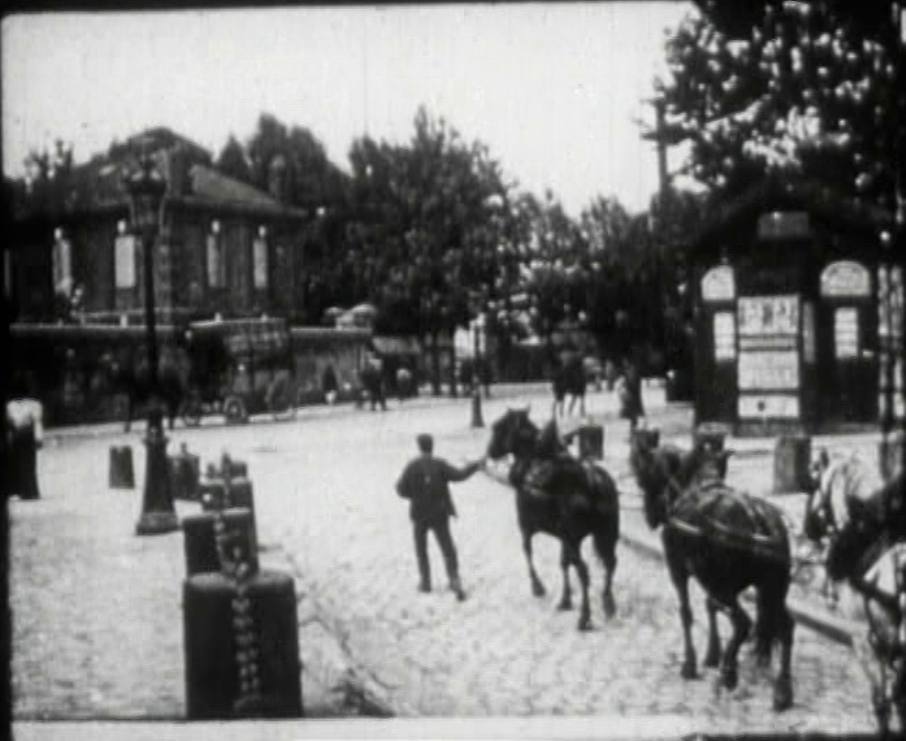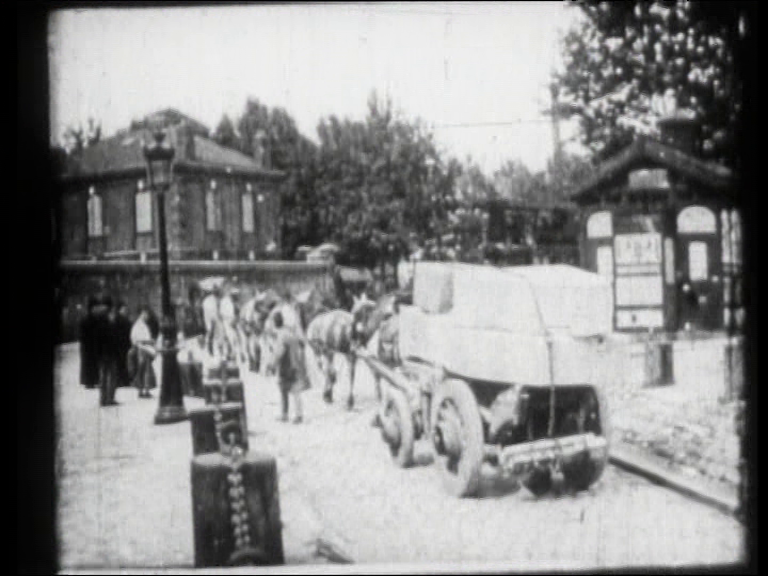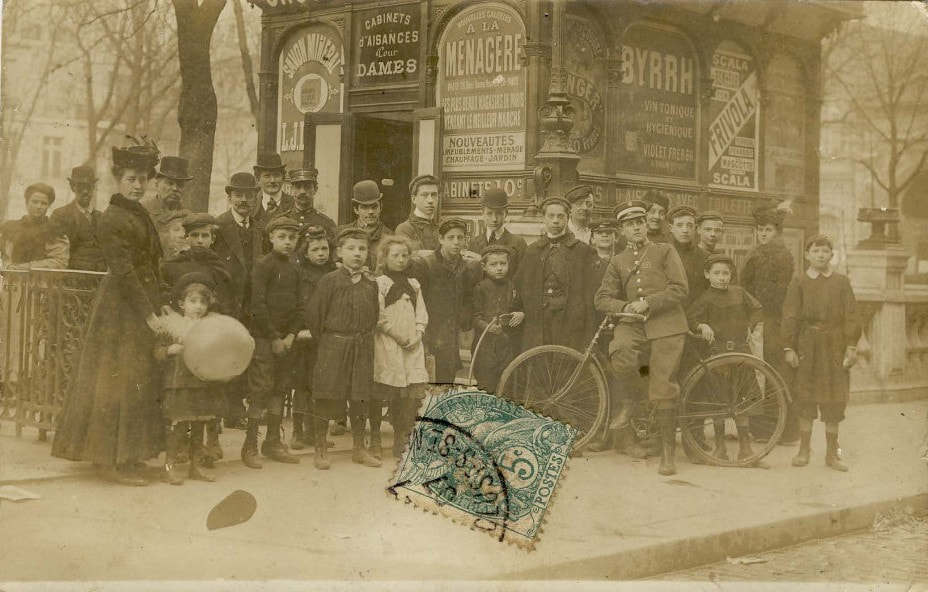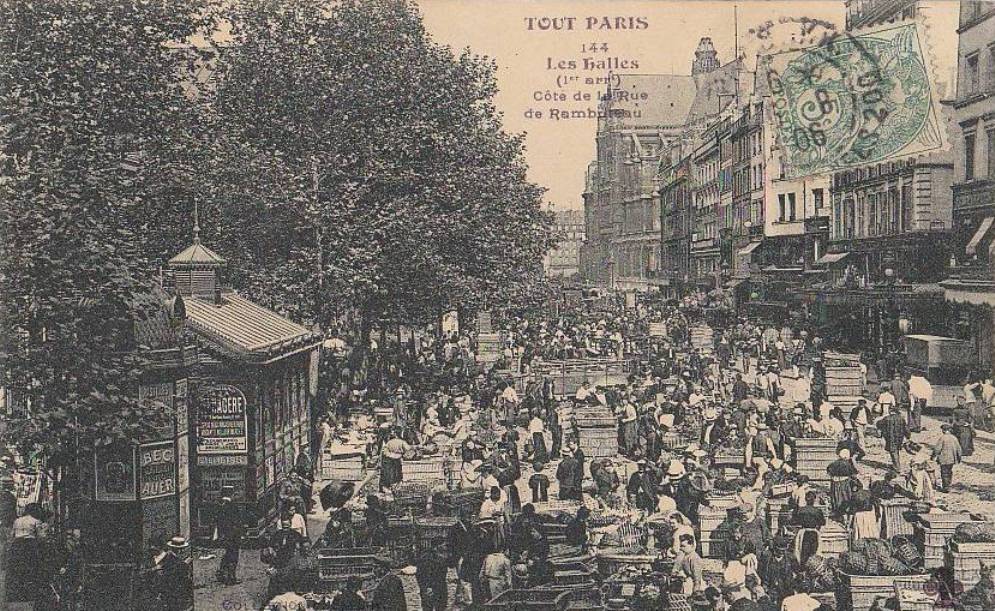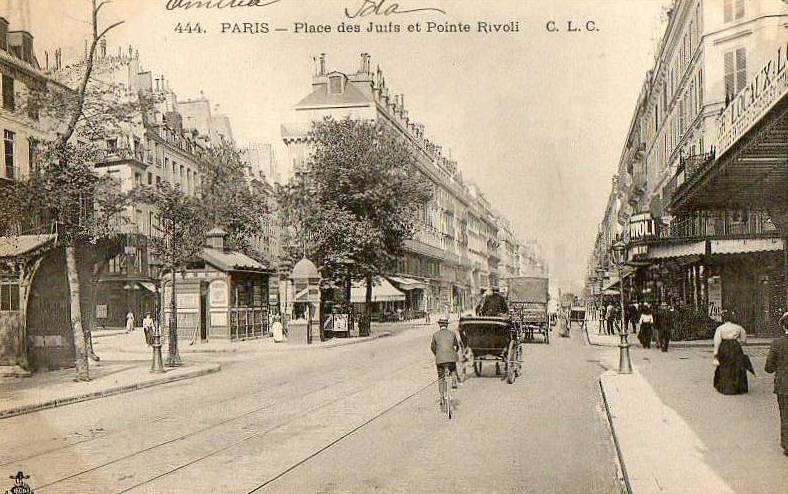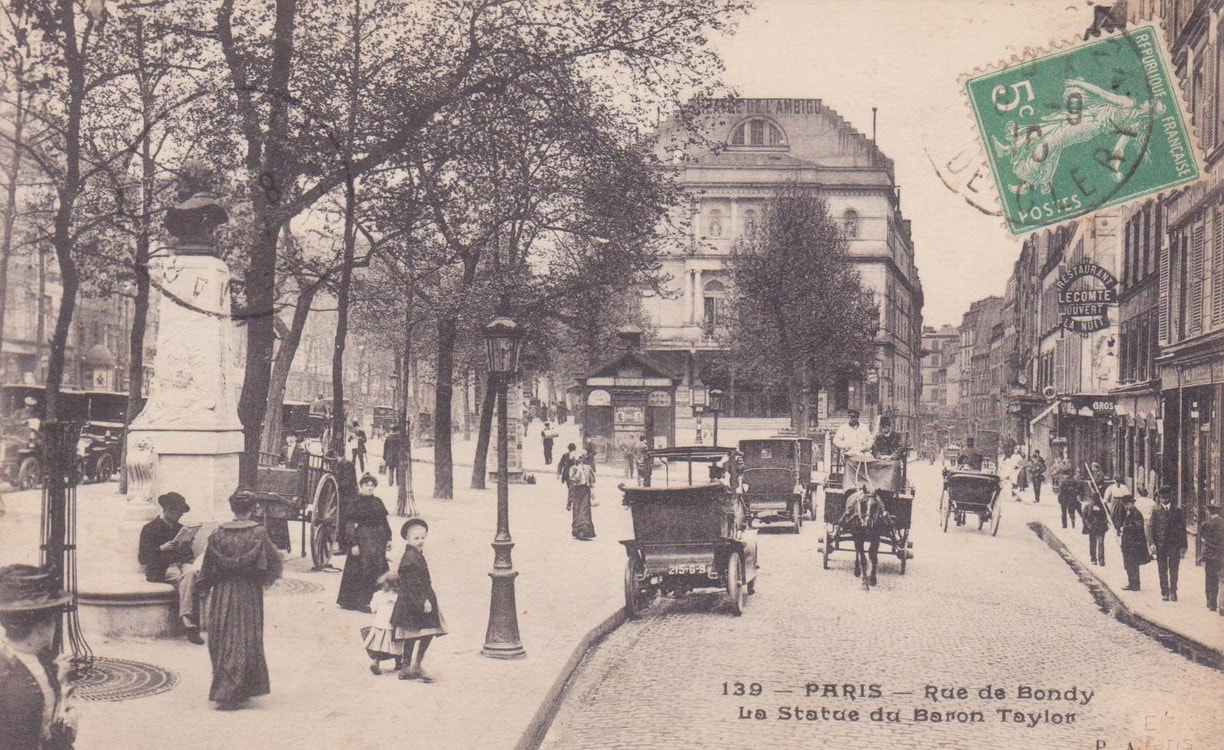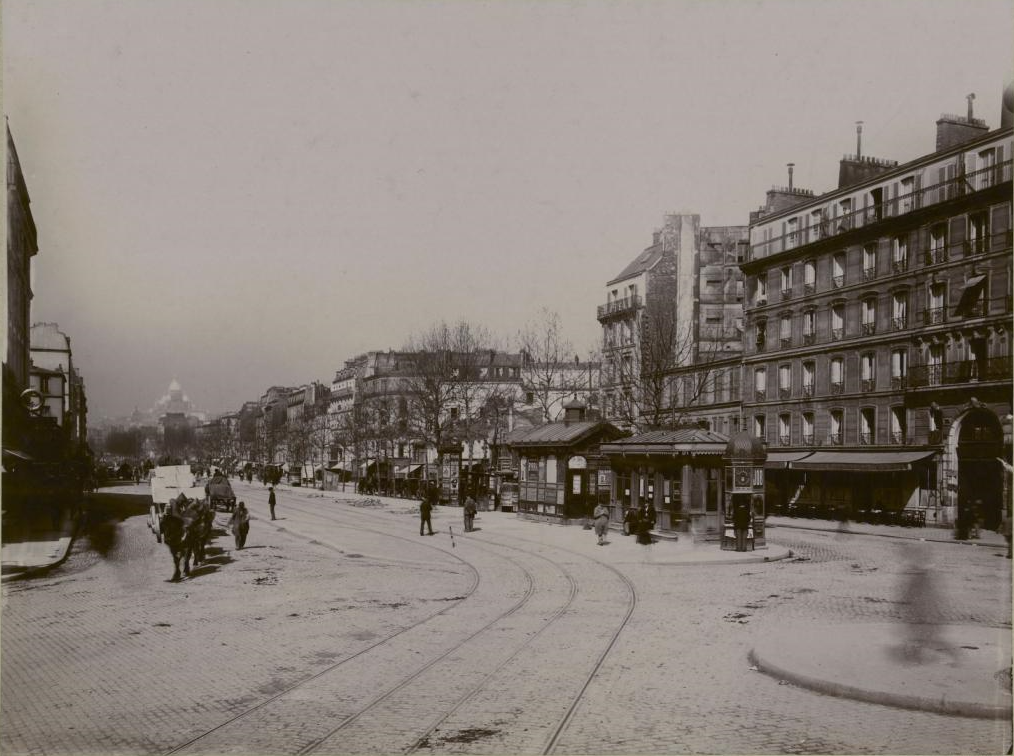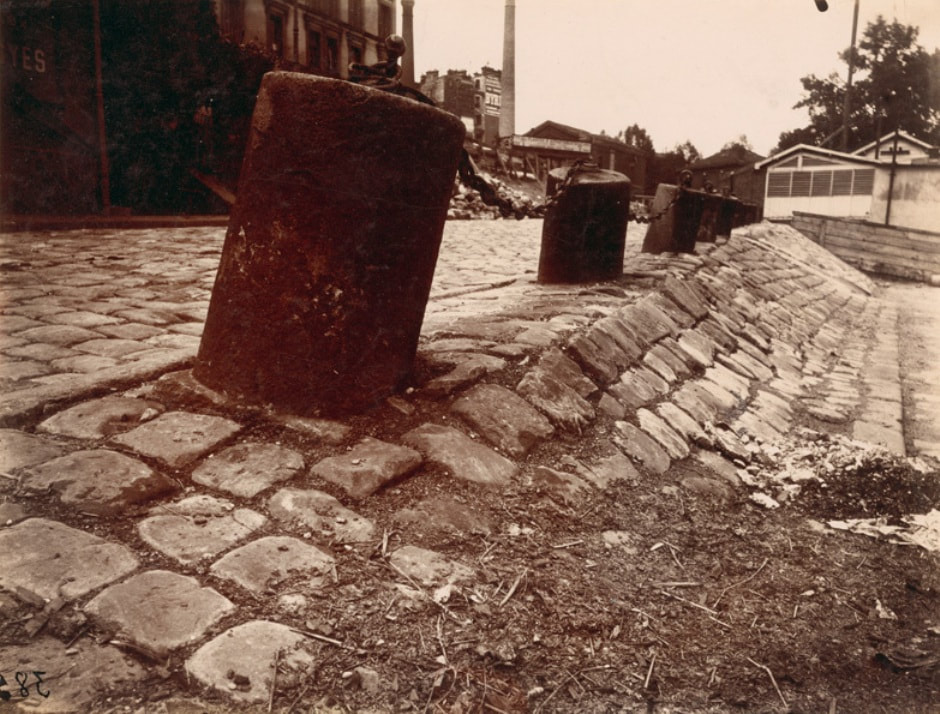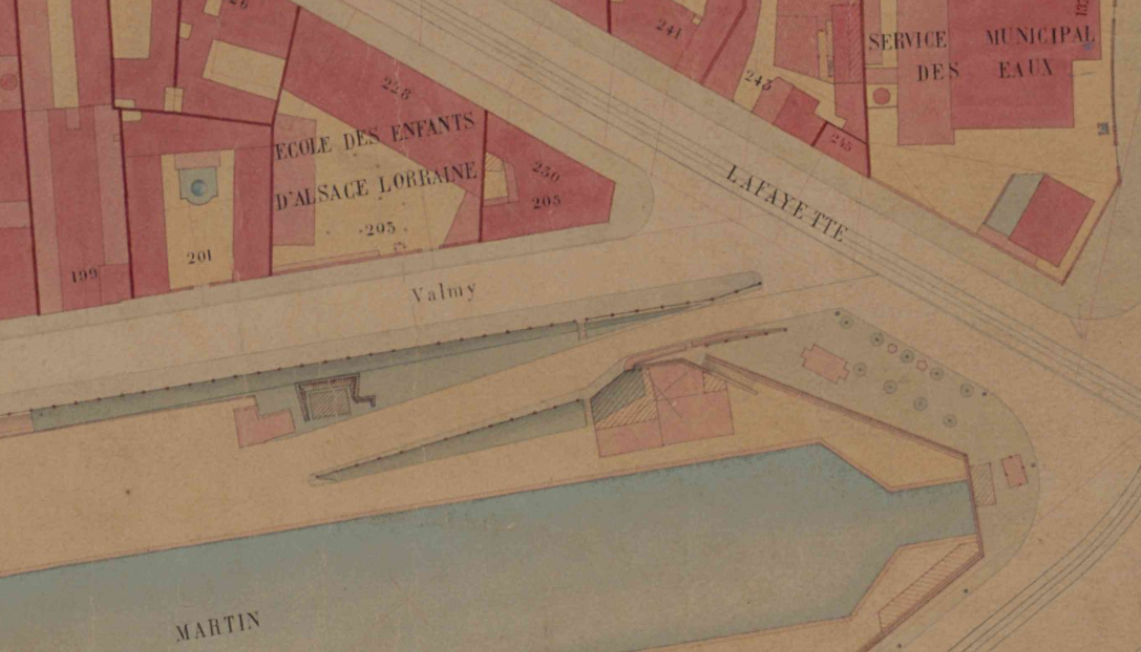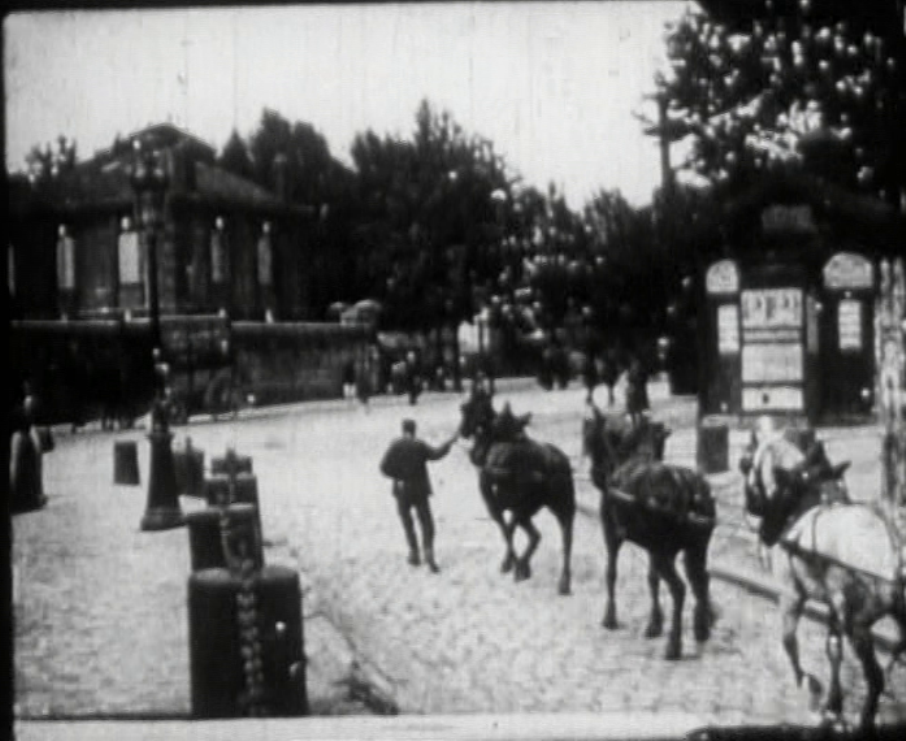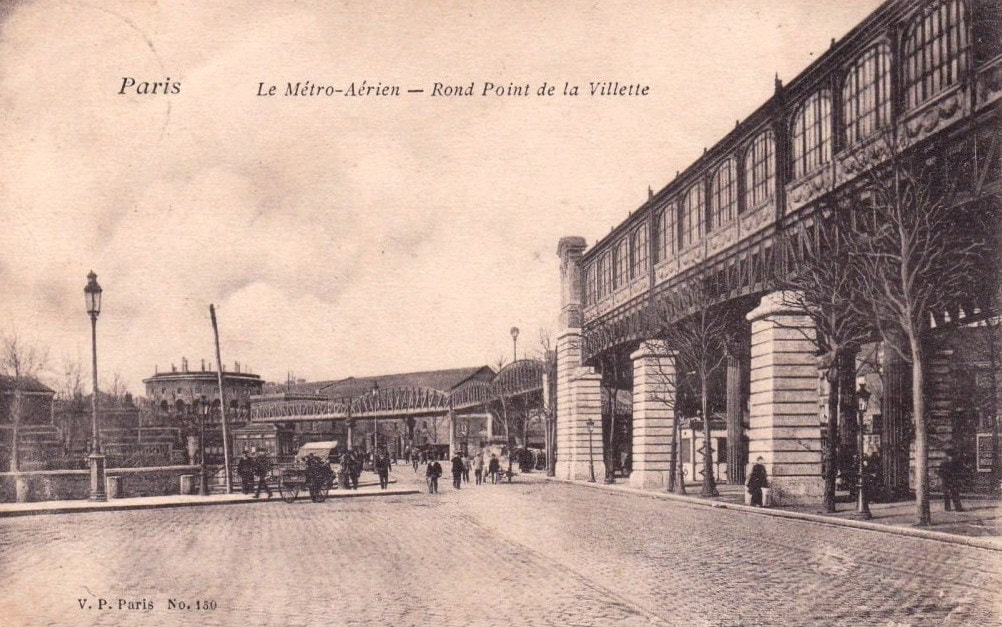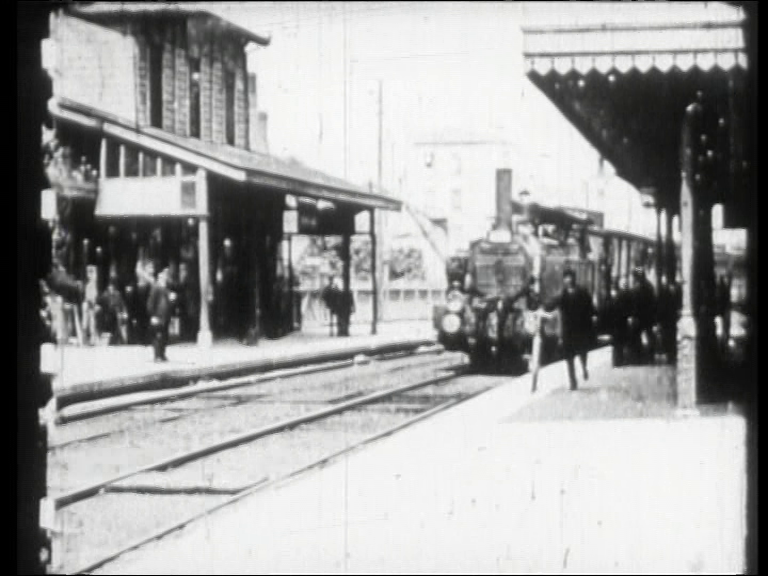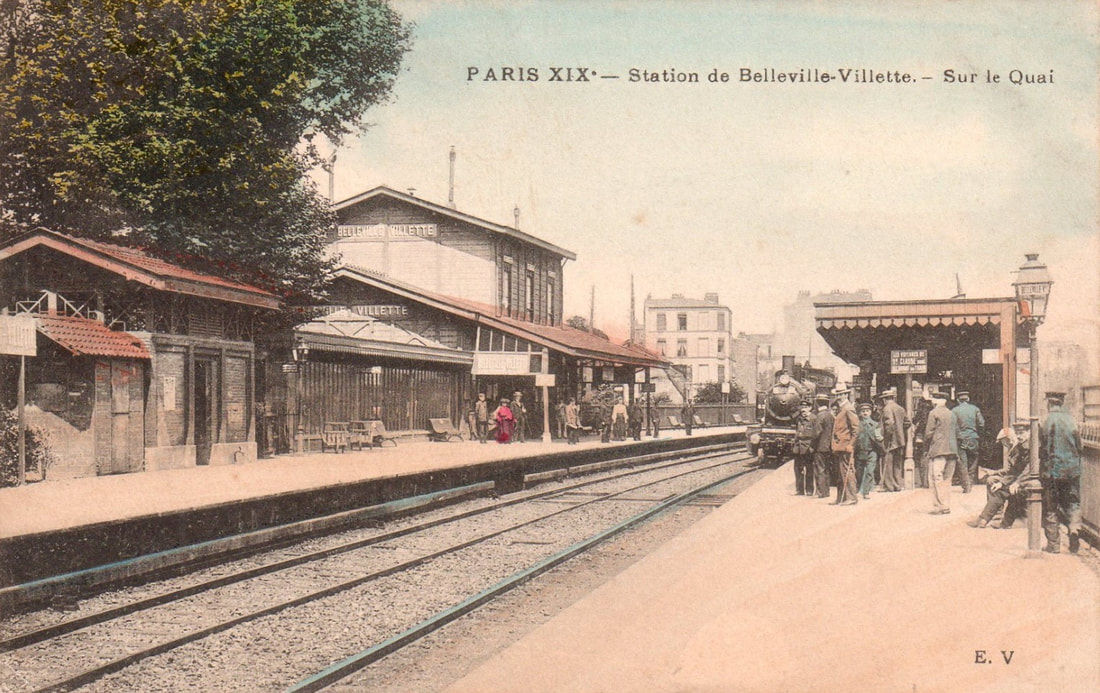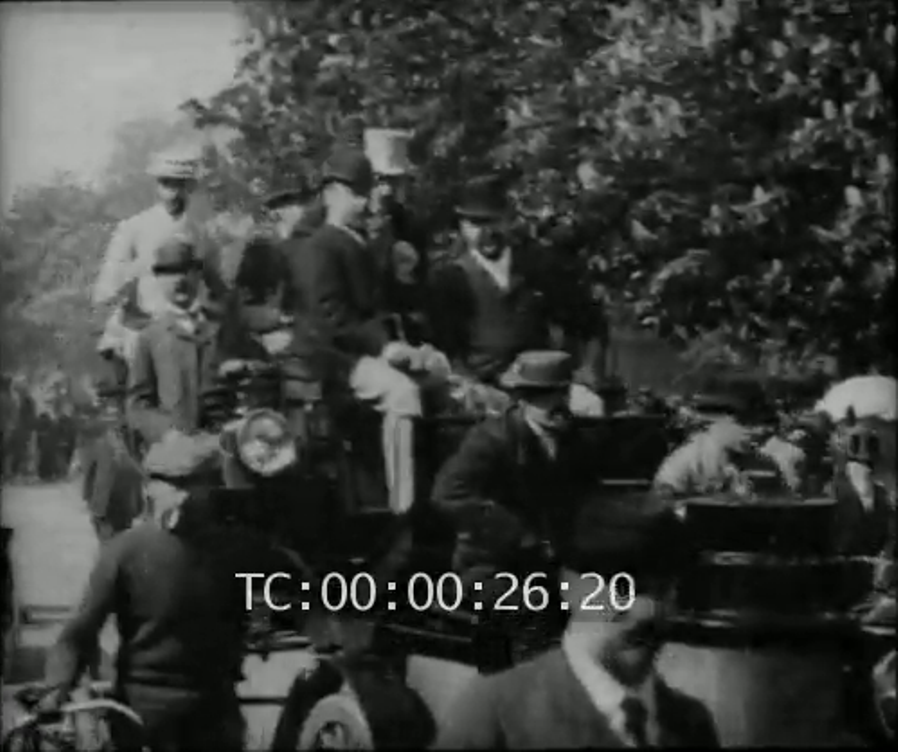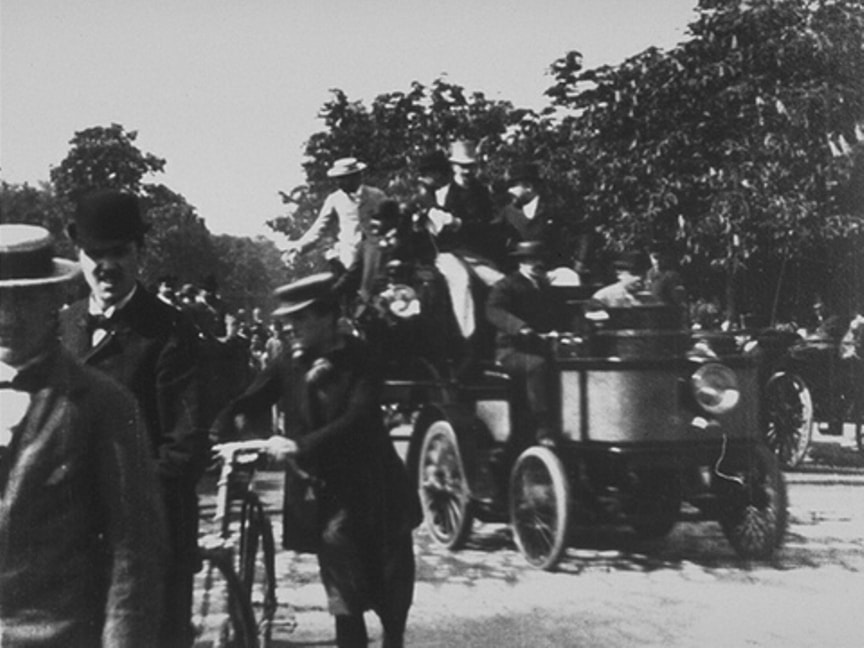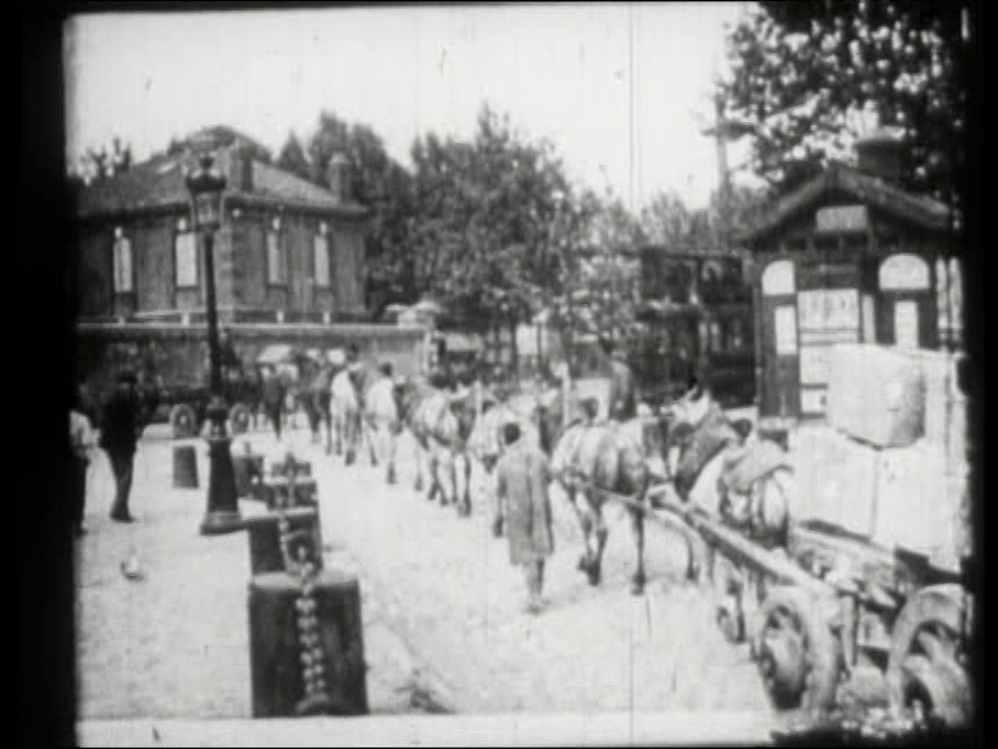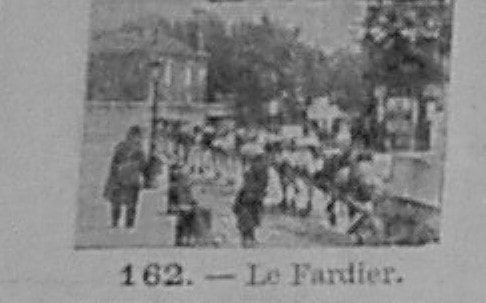views taken at La Villette, c.1896
These two films, consecutive in the 1907 Lumière catalogue (no.624 & no.625), are identical in their framing and almost continuous in their action: a train has pulled up at a platform and from it the livestock has disembarked. The films do not show the arrival of the train, missing the opportunity of introducing novelty to the familar 'train entering a station' motif by showing the disembarcation of bovine rather than, as here at La Ciotat and Lyon, human passengers:
Without the sensation of movement or surprise, the novelty of the La Villette films is only the space itself, a railway station that exclusively serves a livestock market. That is the appeal of these postcards showing sheep, pigs and cows embarking or disembarking at La Villette, or to be precise the Gare de Paris-Bestiaux:
The Gare de Paris-Bestiaux is fully documented here, at the excellent site Association Sauvegarde Petite Ceinture.
|
Actually, these 'Marché aux boeufs' views are not the Lumière-La Villette films that interest me in this post. The livestock market is at the north-eastern extemity of the city, between the Porte de Pantin and the Canal de l'Ourcq. Heading south-west is the Bassin de la Villette with the Rond-Point de la Villette at its tip, where it meets the Canal Saint Martin:
|
|
Here, on the north side of the Canal Saint Martin, as it reaches the Rond-Point de la Villette, some time that same year a Lumière operator, perhaps the same one who filmed the cows at La Villette, filmed horses pulling a wagon loaded with blocks of stone for construction (catalogue no.627). This is one of the finest Lumière films made in Paris, and its restoration for the 2015 dvd is beautiful: |
At a primary level this is simply a generic view, one of several in the Lumière corpus of labouring horses. The actual location can seem as unimportant as the locations of these two views, horses dragging a funnel (catalogue no.770) somewhere near Saint-Etienne and horses dragging a locomotive (no.930) somewhere near Lyon:
But I would argue (of course) that the location of film no.627 actually is important, and that for at least two reasons.
The first is that knowing its location tells us something about the location of the film that precedes it in the catalogue (no.626), which then allows us to correct errors in the information we have on that film.
I should firstly be more specific about where film 627 was shot. The cart that the horses are pulling was laden with stone at the Quai de Valmy on the Canal Saint Martin, below left. From here they headed right, along the path that, in the middle of the postcard below right, we see rising up to street level:
The first is that knowing its location tells us something about the location of the film that precedes it in the catalogue (no.626), which then allows us to correct errors in the information we have on that film.
I should firstly be more specific about where film 627 was shot. The cart that the horses are pulling was laden with stone at the Quai de Valmy on the Canal Saint Martin, below left. From here they headed right, along the path that, in the middle of the postcard below right, we see rising up to street level:
The rising path can be seen on the plan parcellaire below:
At the top of that path are the buildings of the Service Municipal des Eaux that we see in the background of the Lumière film. They can be more easily recognised from this postcard:
What the postcard above left also shows us is that at canal level, between the stone yard and the tunnel under the Rond-Point de la Villette, is a bateau lavoir, a laundry shed. This postcard shows it more clearly:
And in this postcard we can recognise the location of film no.626 in the Lumière catalogue:
The Lumière operator is positioned west of the postcard photographer:
|
There were three bateaux lavoirs on the Canal Saint Martin, all owned by the same company, J. Seignot et Cie, and all of the same design. It is difficult, but not impossible, to tell which one is in the Lumière film.
Here, from 1890, are two photographs by Hippolyte Blancard of the lavoir Grange-aux-Belles, at no.83 Quai de Valmy: |
And this is the lavoir St-Maur, at 137 Quai de Valmy:
Both look very much like the one in the Lumière film, but we can see that the Lumière bateau lavoir corresponds to the lavoir de la Villette, at 201 Quai de Valmy, as seen here from the Rond-Point de la Villette:
The roof of the small hut, the fence behind which the three men are standing, the rough ground sloping upwards and the bollards linked by chains can all be matched. The postcard matches the bollards and the three-windowed white building behind the bateau lavoir.
The Lumière catalogue calls film 626 'washerwomen by the river', rather than by a canal. As far as I can tell this film has not previously been located in Paris. Its pairing with film 627, made at the same location, suggests strongly that the two were made at the same time, by an operator seeking genre subjects in ordinary, working-class Paris. In the catalogue they are preceded by the two La Villette films I discussed at the top of this post. Perhaps all four are from the same time and by the same person.
These views are different from the usual films made in Paris for the Lumière company. There are other exceptions, such as the group of three films showing the fire brigade in action (discussed here), but most Paris-Lumière films from 1896-97 are either of landmark sites - Eiffel Tower, Opéra, Concorde, Arc de Triomphe, Pont-Neuf, etc.:
Or they relate to middle- or upper-class leisure - automobiles at the Porte Maillot, animals at the Jardin d'Acclimatation, children in the Tuileries gardens or on the Champs Elysées...:
The second reason why identifying the location of film 627 is important is that the knowledge modifies slightly a common perception that landmark or event-related locations are the only ones that recur across the catalogues of different companies in these first two years or so of the cinema.
Films of carnival parades and state visits (especially the visit of the Tsar and Tsarina) litter the early catalogues of Lumière, Méliès, Pathé and Gaumont. See here for the recurrence of the Place de l'Opéra in these and other catalogues. Other overlaps of place include Place de la Concorde (Lumière, Méliès, Pathé), Champs Elysées (Lumière, Pathé, Gaumont), Gare Saint Lazare (Méliès, Gaumont), Bois de Boulogne (Lumière, Méliès, Pathé, Gaumont), Place de la République (Lumière, Pathé), Arc de Triomphe (Lumière, Pathé), etc.
Films of carnival parades and state visits (especially the visit of the Tsar and Tsarina) litter the early catalogues of Lumière, Méliès, Pathé and Gaumont. See here for the recurrence of the Place de l'Opéra in these and other catalogues. Other overlaps of place include Place de la Concorde (Lumière, Méliès, Pathé), Champs Elysées (Lumière, Pathé, Gaumont), Gare Saint Lazare (Méliès, Gaumont), Bois de Boulogne (Lumière, Méliès, Pathé, Gaumont), Place de la République (Lumière, Pathé), Arc de Triomphe (Lumière, Pathé), etc.
Generic subjects also recur across these catalogues, looking sometimes like mutual plagiarisms. The subject of film 627, 'Attelage d'un camion', recurs in a Gaumont film titled 'Le Fardier' ('The Lowry' in the 1897 English catalogue). As we have seen, the same subjects appealed to filmmakers, postcard editors and photographers. There are a few Paris postcards showing stone-laden carts drawn by horses:
And the subject is common in Atget's work:
The postcard views are of streets in the seventh and fifteenth arrondissements, far from where these blocks of stone were brought by barge into Paris, and we can conclude that the photographers encountered the horses and carts by chance. Atget, on the other hand, for the second and third views above, went to unloading sites on the Bassin de la Villette and the Canal Saint Martin, knowing that there he would find subjects such as this. I conjecture that the Lumière operator did the same, looking for this subject, and likewise the operator who took the Demenÿ-Gaumont camera around Paris in 1896-97, and who filmed a stone-laden cart drawn by ten horses in exactly the same place seen in the Lumière film, coming up from the Quay de Valmy towards the buildings of the Service Municipal des Eaux, at the Rond-Point de la Villette:
|
I hope that some day there will be a restoration of 'Le Fardier'; in its deteriorated state it is still possible to see how wonderful a film this is, full of detail and action, and the equal of the Lumière film. The camera is on the other side of the street, at an angle that takes in more of the objects in the space - bollards linked by chains, lamp-post, some sort of sentry box against the wall at the back, the distinctive building of the water company, trees and, on the right hand side, a chalet de nécessité or cabinet d'aisance, a public toilet. |
The action of the film is perfectly timed. We see the slow chain of horses advance, not yet knowing how many there will be nor what they are pulling, and then a double-decker tram crosses the horses' path, itself pulling a trailer. The contrast of speed between the two modes of transport, between tradition and modernity, is already dramatic by the time the cart with its load appears:
The play of shapes and shades, of lines and trajectories, speaks of how carefully the operator chose a position from which to film.
I began the research for this post here, with this film, frustrated that I didn't know where all this drama had been played out. There seemed to me sufficient clues to follow up, not the least of which was that lavatory facility. Here are several of the same model, from all over Paris:
None of these matches the film, and nor did any of the locations where the presence of a W.C. was indicated (e.g. in a newspaper report).
The next clue I followed was the tram, and I found that only ligne AD had this particualr type of tram at the time: I looked everywhere along that line, from the Cours de Vincennes to the Gare Saint Lazare, but couldn't find a building to match the one in the film. This type of building, with late nineteenth-century variegated brickwork, suggested an outer district of Paris, but that didn't narrow things down very much.
Then I wondered about the sentry box, thinking the wall and building might be associated with army barracks. All barracks in Paris can be seen on period postcards, and most of them are still there today, but I still couldn't find a match.
I next looked into the bollards with chains, not a common feature in Paris streets. It was eventually a mention of 'bornes liées par chaînes' near a canal that sent me looking around La Villette. If I had known this photograph by Atget of bollards linked by chains I might have found the location quicker, though I would have had to look very closely to realise that in the far background of Atget's photograph is the Service des Eaux building:
The next clue I followed was the tram, and I found that only ligne AD had this particualr type of tram at the time: I looked everywhere along that line, from the Cours de Vincennes to the Gare Saint Lazare, but couldn't find a building to match the one in the film. This type of building, with late nineteenth-century variegated brickwork, suggested an outer district of Paris, but that didn't narrow things down very much.
Then I wondered about the sentry box, thinking the wall and building might be associated with army barracks. All barracks in Paris can be seen on period postcards, and most of them are still there today, but I still couldn't find a match.
I next looked into the bollards with chains, not a common feature in Paris streets. It was eventually a mention of 'bornes liées par chaînes' near a canal that sent me looking around La Villette. If I had known this photograph by Atget of bollards linked by chains I might have found the location quicker, though I would have had to look very closely to realise that in the far background of Atget's photograph is the Service des Eaux building:
These are the bollards we see in the film. They are indicated on the plan parcellaire, each side of the path up which the horses have dragged their load:
I didn't see the Atget photograph till yesterday, but I had in the meantime spotted the Service des Eaux building in this photograph, showing the viaduct of the Métro under construction:
|
The chalet de nécessité is there, to the left, and we can just see to its left one of the bollards lining the right side of the path. The trees are there, but what we can't see in the film is the Métro viaduct, because when the film was made it was not yet under construction. I haven't found out yet when exactly the pillars supporting the Rue d'Allemagne métro station were erected. The station wasn't opened until February 1903, so it is probably fanciful of me to think that the blocks of stone in this and the Lumière film ended up here, as part of the station, and that the horses hadn't had to pull them too far:
|
I suggested above that the four Lumière films near La Villette were made by the same operator and at the same time. I don't know enough, yet, about how and by whom the Lumière Paris films were made. I imagine that there were operators permanently based in Paris, but it wouldn't have been difficult to send an operator up from Lyon whenever an event was to be documented, in which case it could have been Promio or Moisson or Mesguich or Girel or Veyre... or some other as yet undocumented operator.
A similar uncertainty arises concerning the maker of the Demenÿ-Gaumont film 'Le Fardier'. Laurent Mannoni (Georges Demenÿ, pionnier du cinéma, p.106) says that it is almost certain that Demenÿ made a number of the films in the first Gaumont catalogue, though we do not know which ones. Sometimes proximity to a particular home or base gives a clue, but none of the Paris subjects listed in that catalogue is especially near Demenÿ's home at Levallois-Perret. One of those films, 'Avenue de l'Opéra', was made near the Gaumont office on Rue Saint Roch, so it could have been by someone based there. The La Villette location of 'Le Fardier' is quite near the Gaumont factory in Belleville, and there is another film made in that vicinity, of a train entering a station. The catalogue says this is 'Ménilmontant station, Ceinture railway', though in fact it is a station a little nearer the Gaumont factory, Belleville-Villette:
This and 'Le Fardier' could have been made by anyone from the Cité Elgé who could operate the camera - see the list of Gaumont operators compiled in 1998 by Michelle Aubert for the CNC Bois d'Arcy:
The list should really include Alice Guy, even though only a few specialists allow that she was making films at this time, and also Léon Gaumont himself, who made no. 9 in his Catalogue, showing 'Motor Carriages at the Porte Maillot'. This event, the start of an excursion by members of L'Automobile-Club from Paris to Meulan on May 14th, was also filmed by Lumière operator Clément Maurice:
Probably the name of the maker of no. 44 in the Gaumont catalogue, 'Le Fardier', will remain unknown, despite the film's great quality. The company deemed the film of sufficient interest to retain it in the 1900 catalogue, in a 35mm print rather than the original 58mm. There is a slight enigma here. The photogram in that catalogue confirms that the subject of this 'Le Fardier' is exactly the same as the film from 1896-97:
However, examining the moment of the film where the cart is in the same position as in the photogram, above, we notice four differences (despite the poor quality of the reproduction): in the catalogue image, the man walking on the pavement to the left is nearer the camera and further from the lamp-post; on the street itself there are two men walking alongside the horses, whereas in the film there is only one; the position of the stones on the cart appears to be different; and the lamp-post appears in a slightly different position in relation to the building behind it.
These are images from two different films, though I can't believe they weren't taken on the same day, at the same time. The version of the film I have been examining is the one preserved at the NFTVA, the 'Demeny Programme' compiled from films that had belonged to the English exhibitor William Slade. The copy that can be viewed at the Gaumont Pathé Archives is of the same film.
Perhaps in another archive somewhere is a version of the film illustrated in the catalogue. If I find out more I shall update this post.
These are images from two different films, though I can't believe they weren't taken on the same day, at the same time. The version of the film I have been examining is the one preserved at the NFTVA, the 'Demeny Programme' compiled from films that had belonged to the English exhibitor William Slade. The copy that can be viewed at the Gaumont Pathé Archives is of the same film.
Perhaps in another archive somewhere is a version of the film illustrated in the catalogue. If I find out more I shall update this post.
References and sources
- Patricia Cook, 'Slade's Electro-Photo Marvel: Touring Film Exhibition in Late Victorian Britain', PhD thesis, Birkbeck College (2016)
- Maurice Gianati & Laurent Mannoni, Alice Guy, Léon Gaumont et les débuts du film sonore (New Barnet: John Libbey, 2012)
- Alison McMahan, Alice Guy Blaché: Lost Visionary of the Cinema (New York: Continuum, 2002)
- Laurent Mannoni, Marc de Ferrière le Vayer & Paul Demeny, Georges Demenÿ pionnier du cinéma (Douai: Editions Pagine, 1997)
- Jacques Rittaud-Hutinet, Auguste et Louis Lumière: les 1000 premiers films (Paris: Philippe Sers, 1990)
- Le Service des Archives du Film du CNC, 'New Restoration Projects/Nouveaux projets de restauration', Journal of Film Preservation 56 (June 1998)
- Be Natural: the Untold Story of Alice Guy-Blaché (Pamela B. Green, US, 2018)
- Lumière! Le Cinématographe 1895-1905 - dvd compilation presented by Bertrand Tavernier & Thierry Frémaux (France, 2015)
I am indebted for information and images to the BNF-Gallica service, Les Archives de Paris, the CNC Bois d'Arcy, the online Catalogue Lumière and the Association Sauvegarde Petite Ceinture. My thanks to them.
Postcards such as those I have included above can be found for purchase at Delcampe.net.
